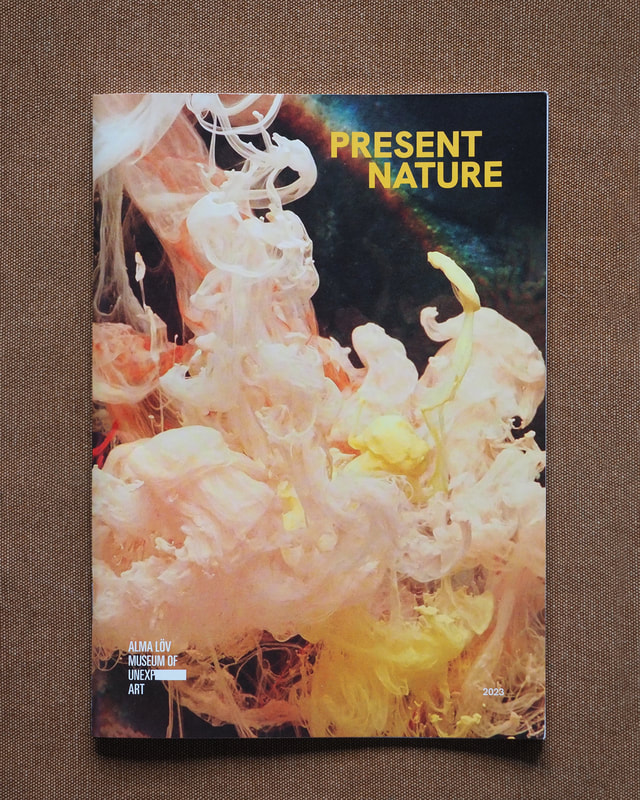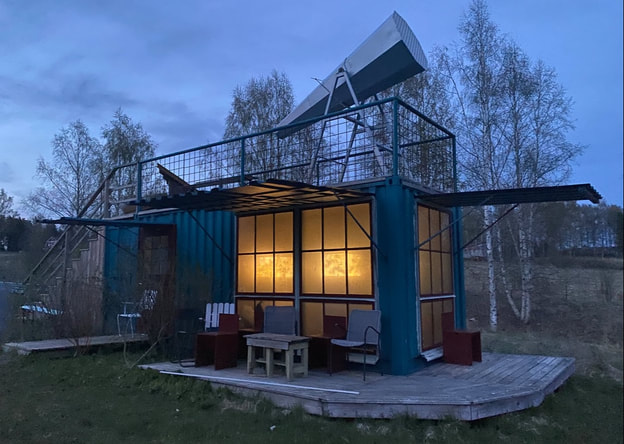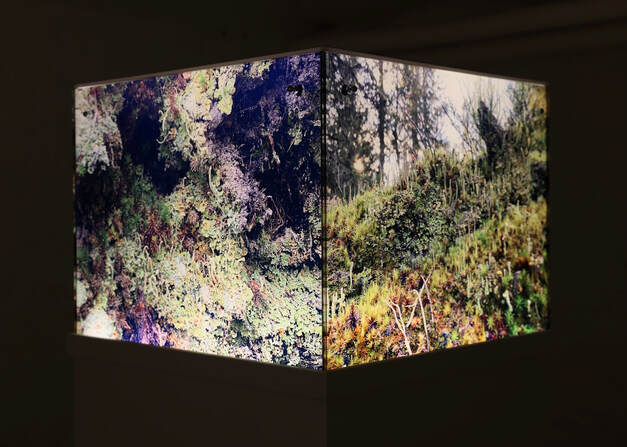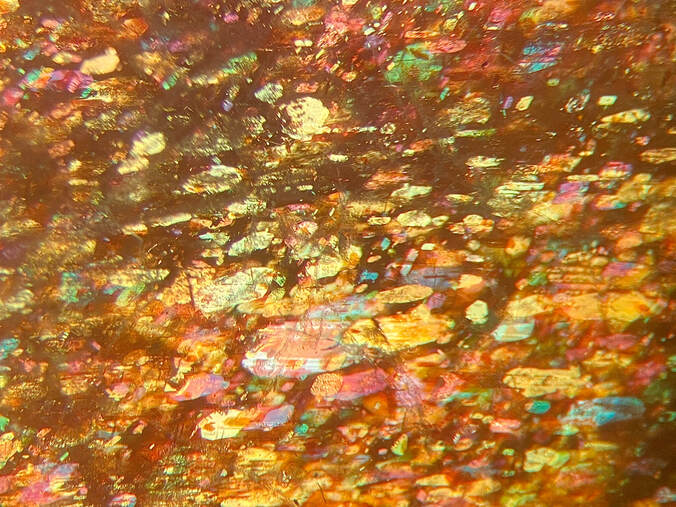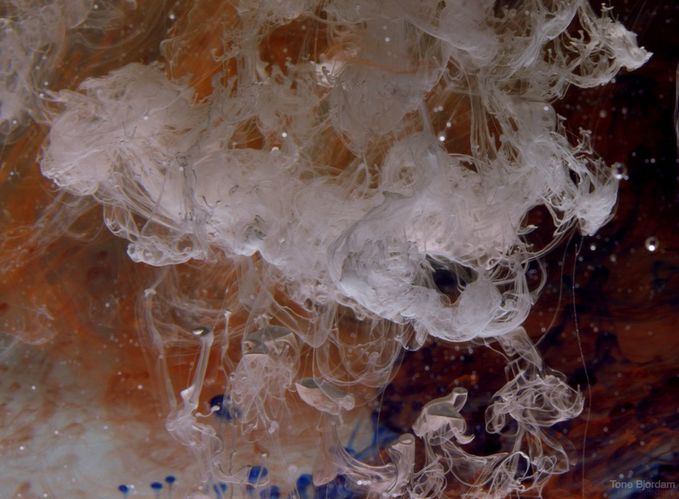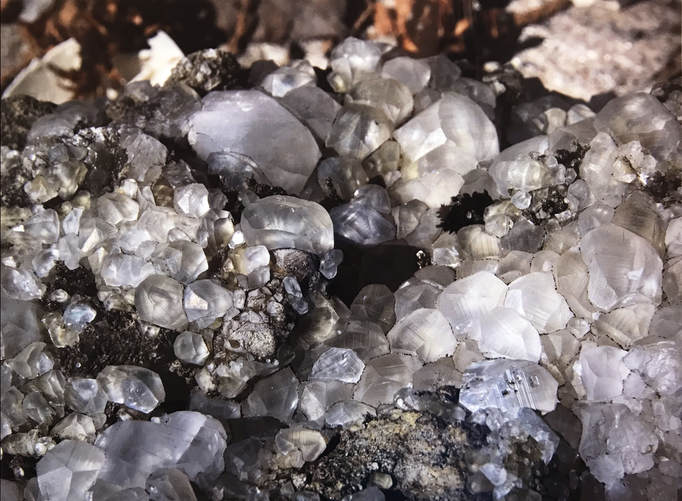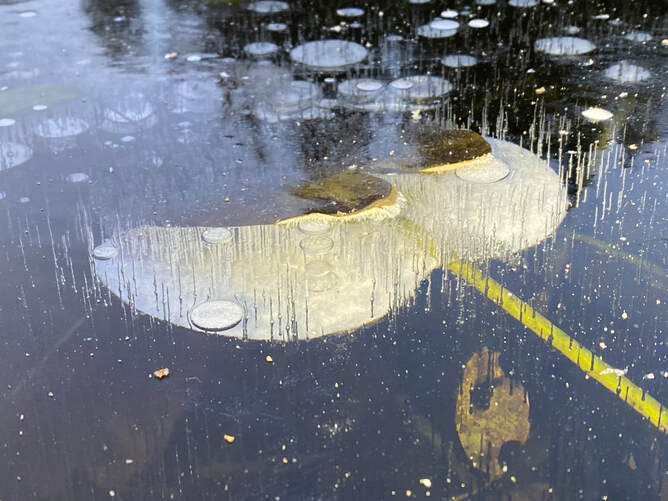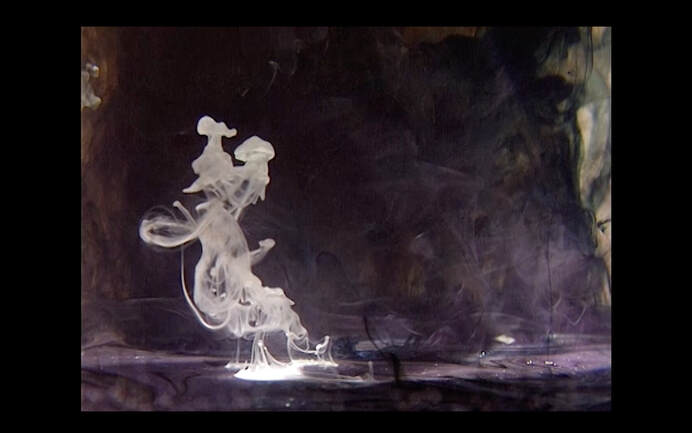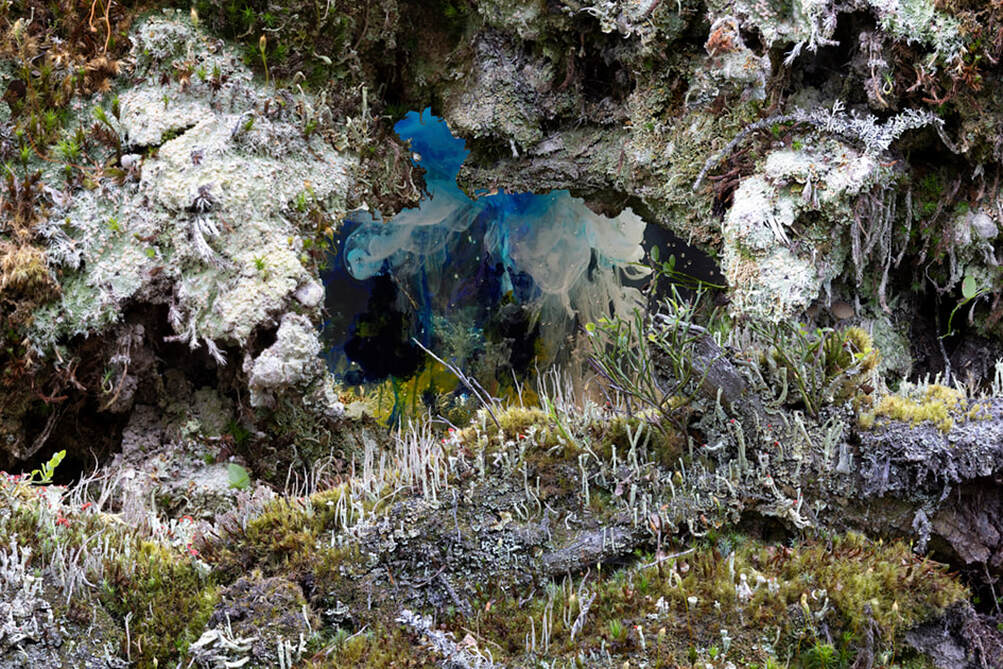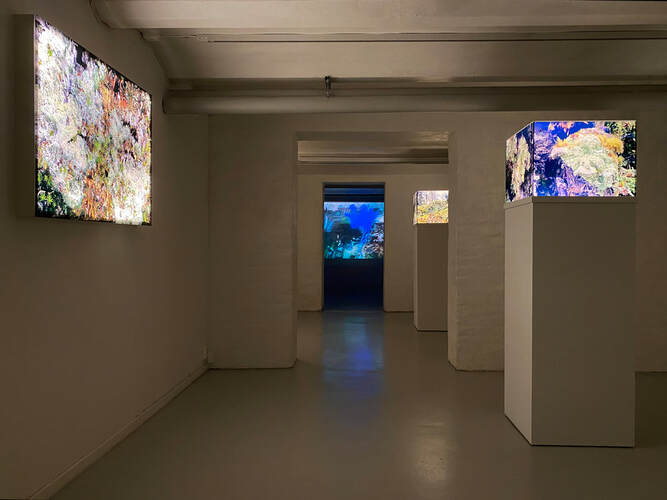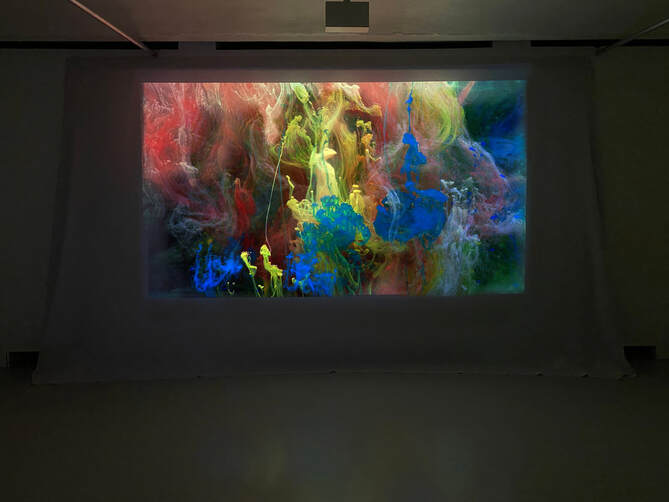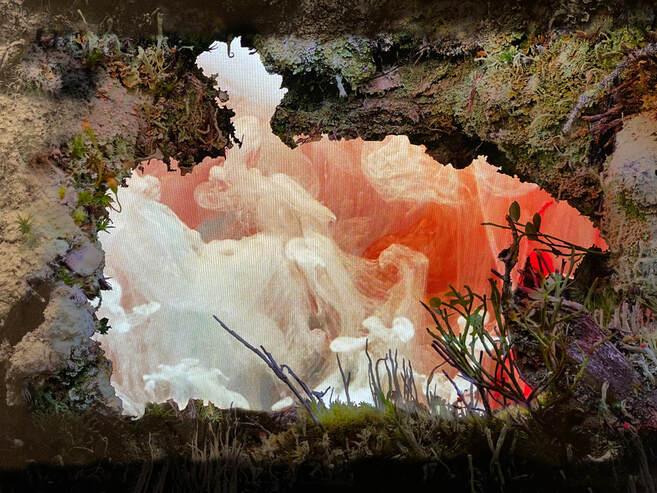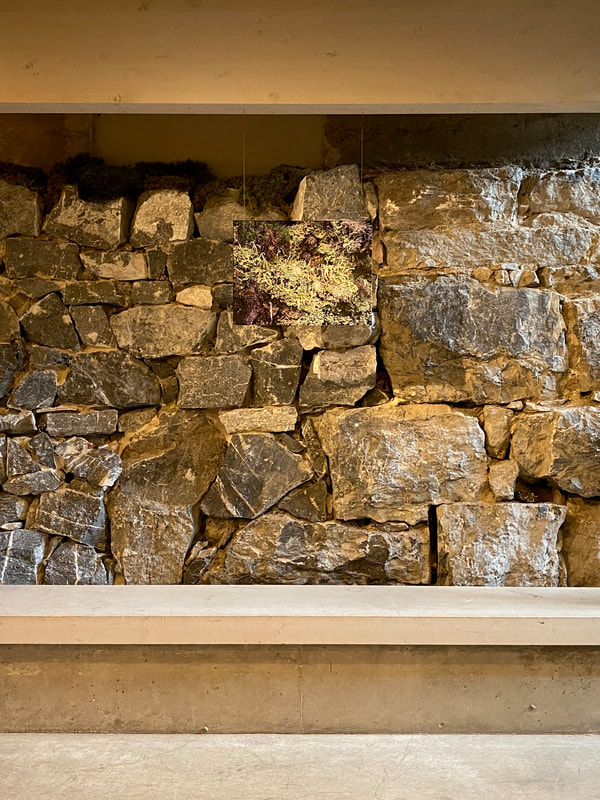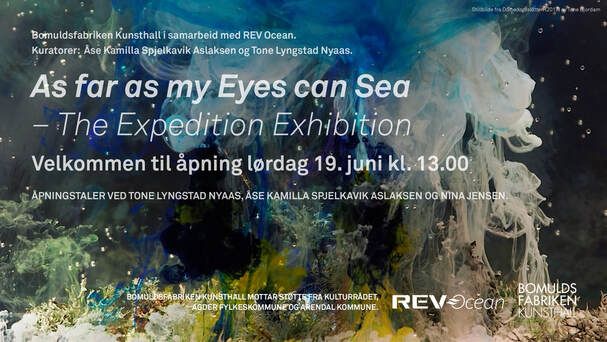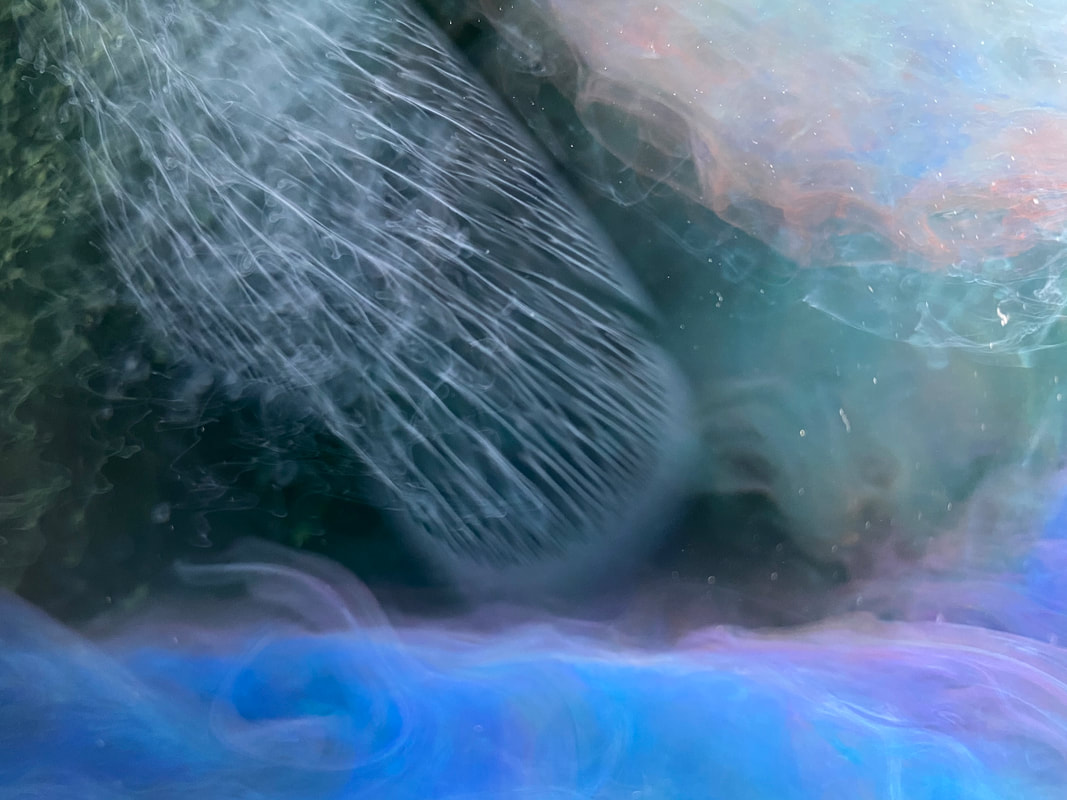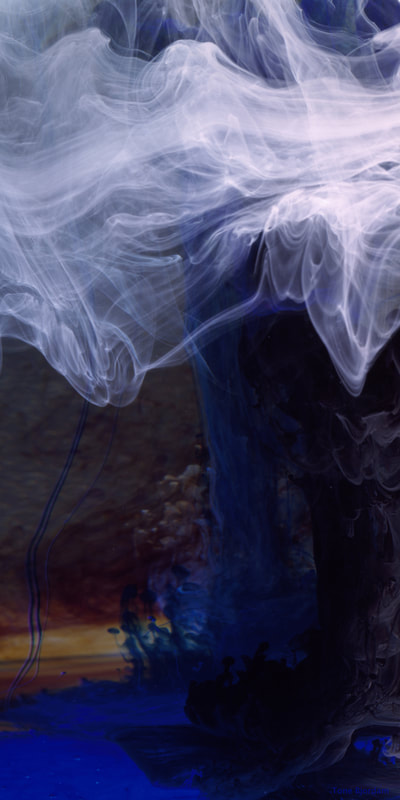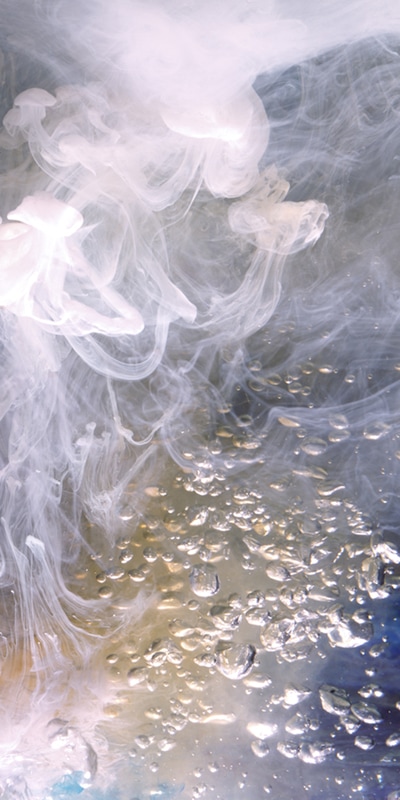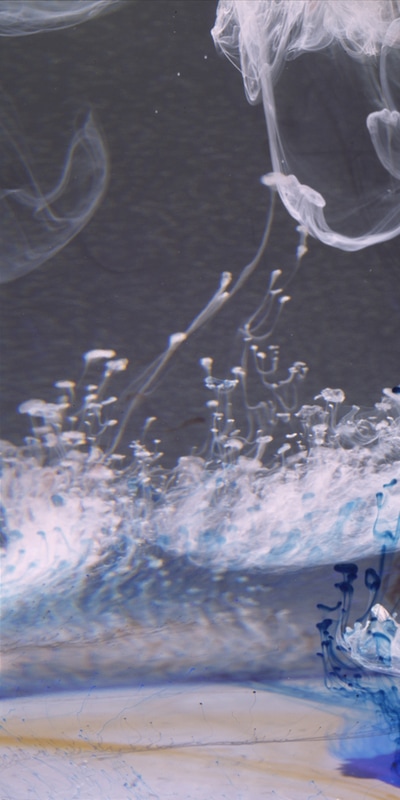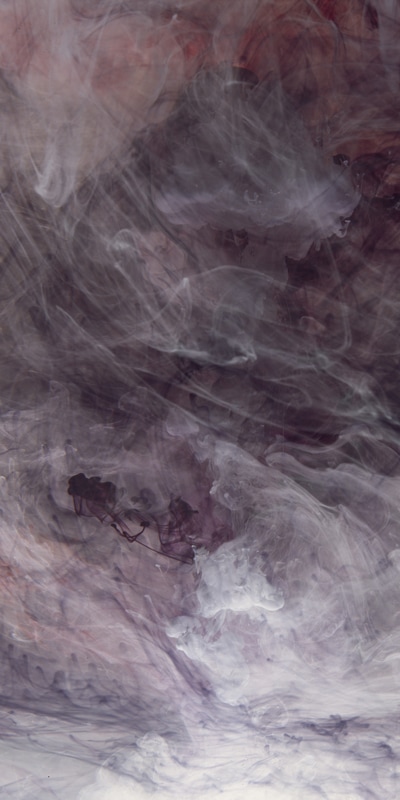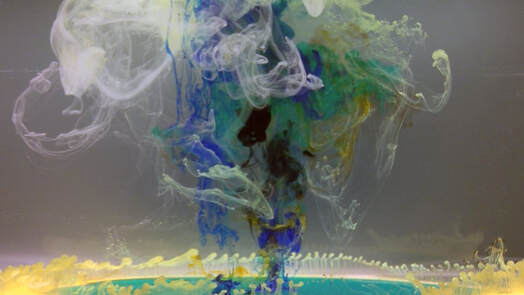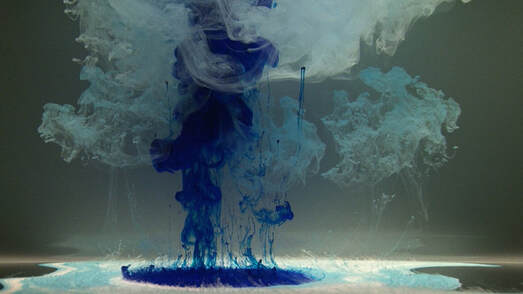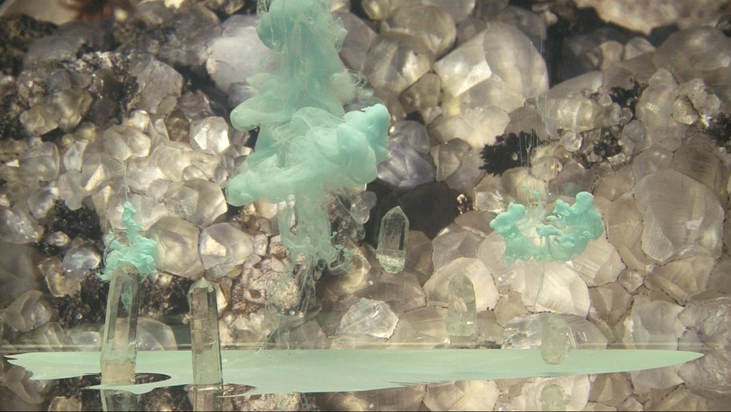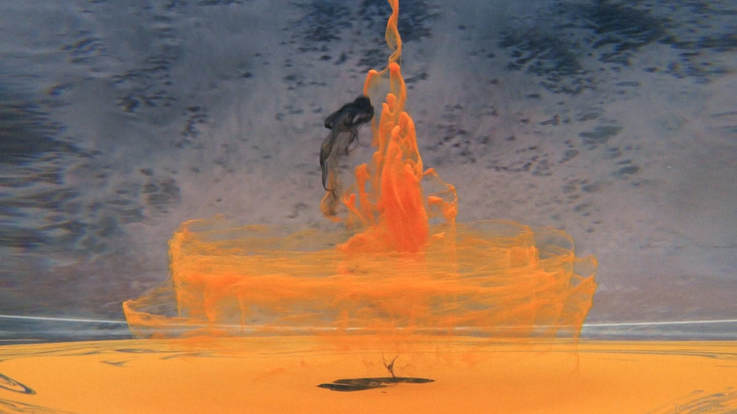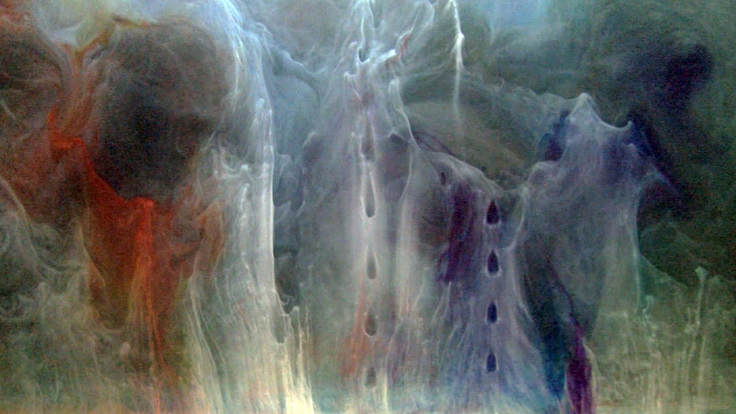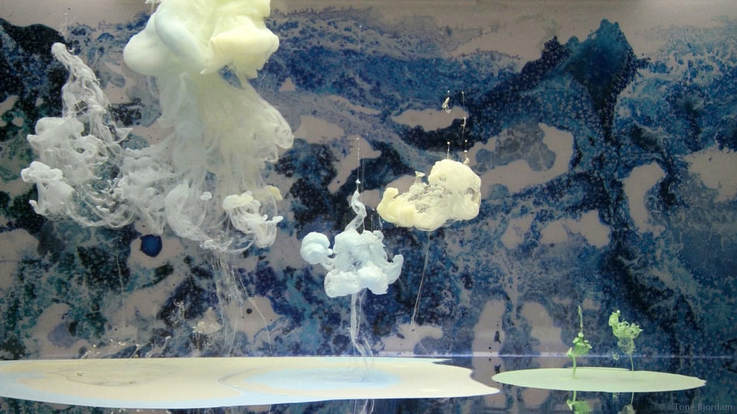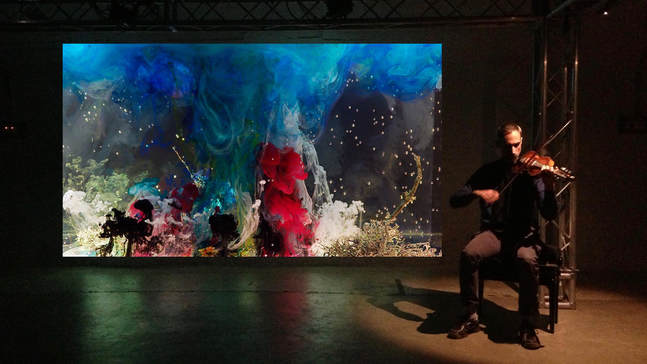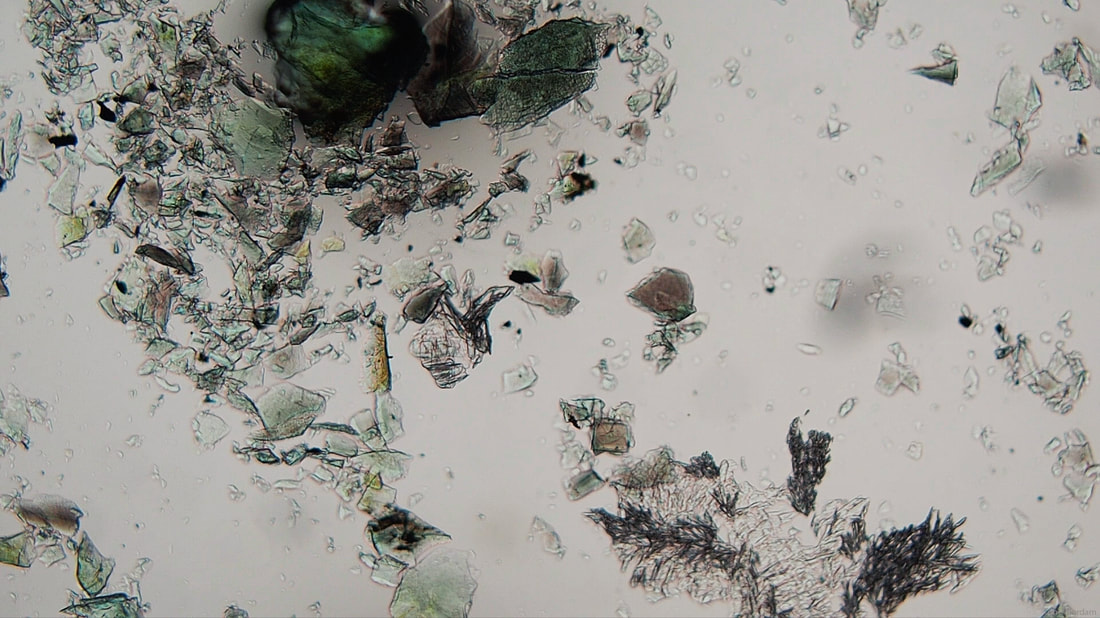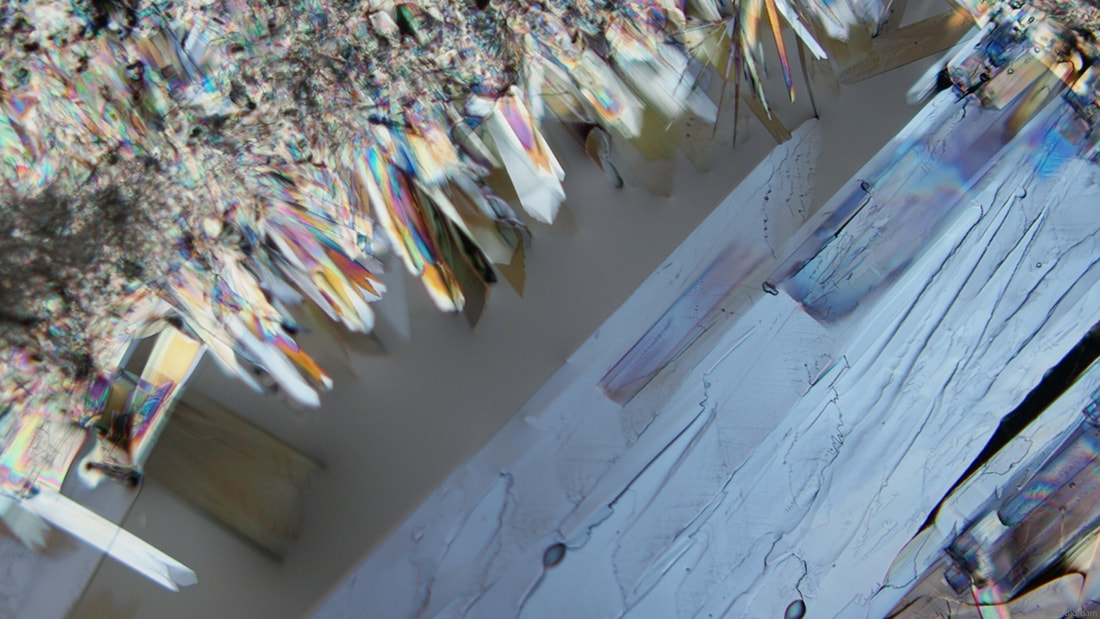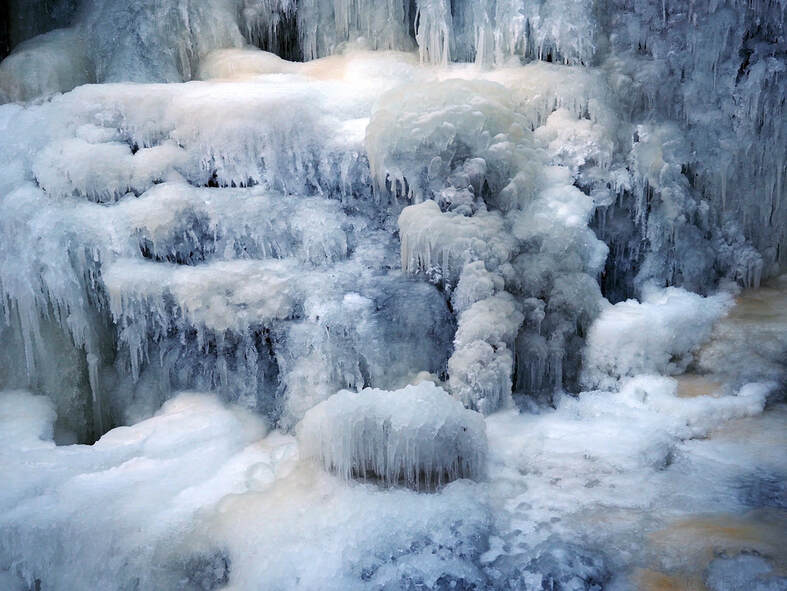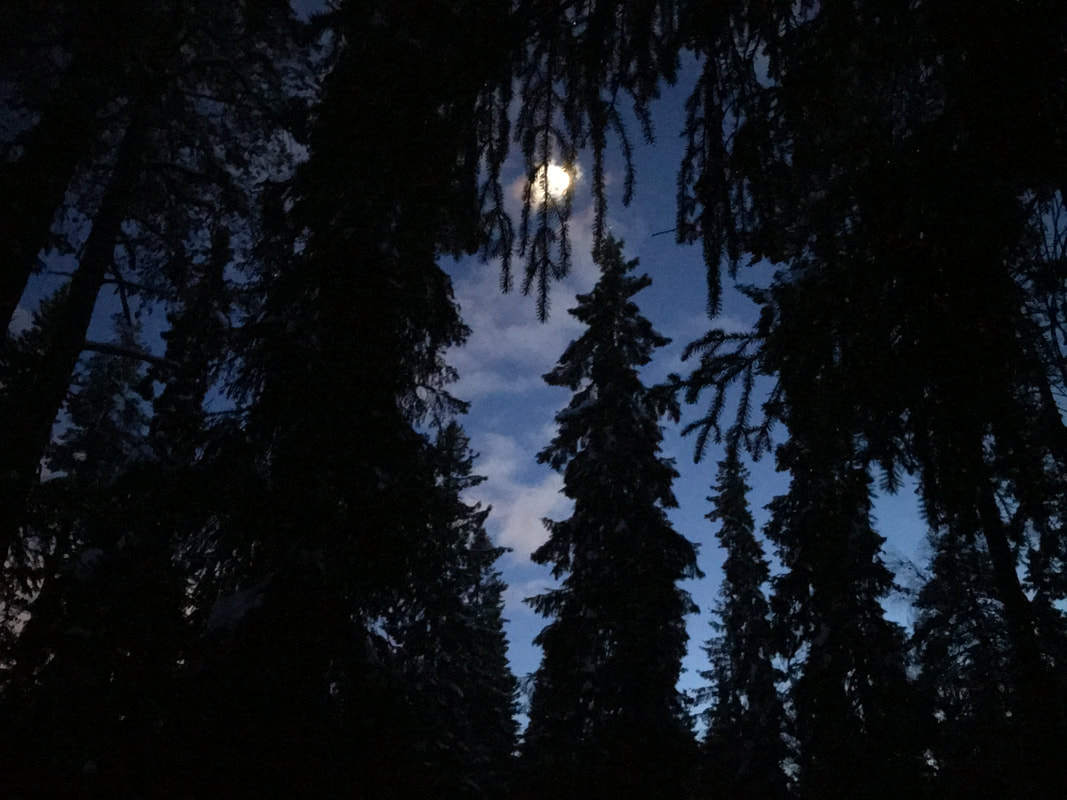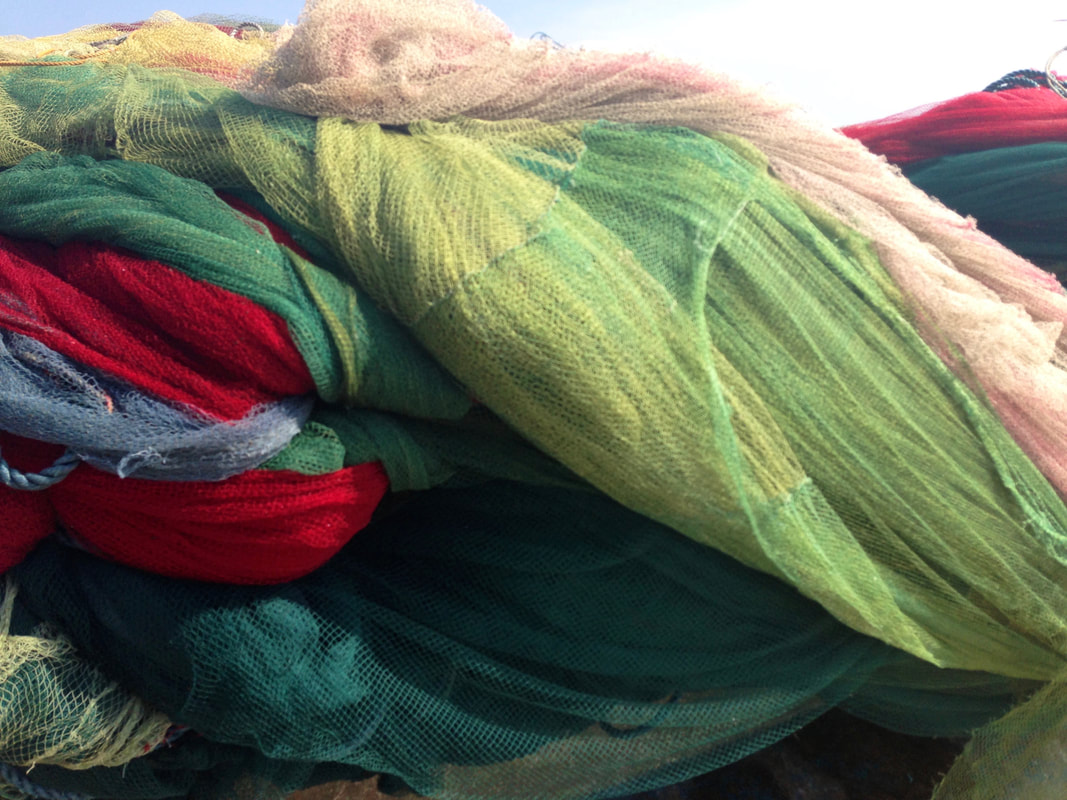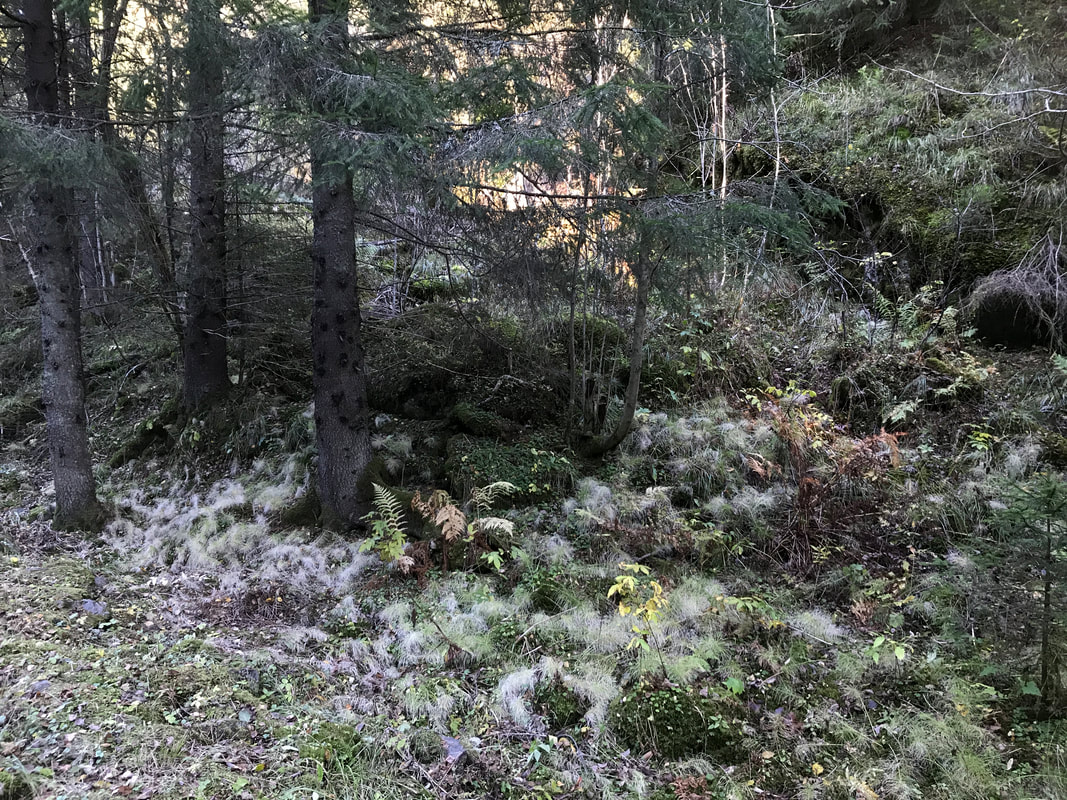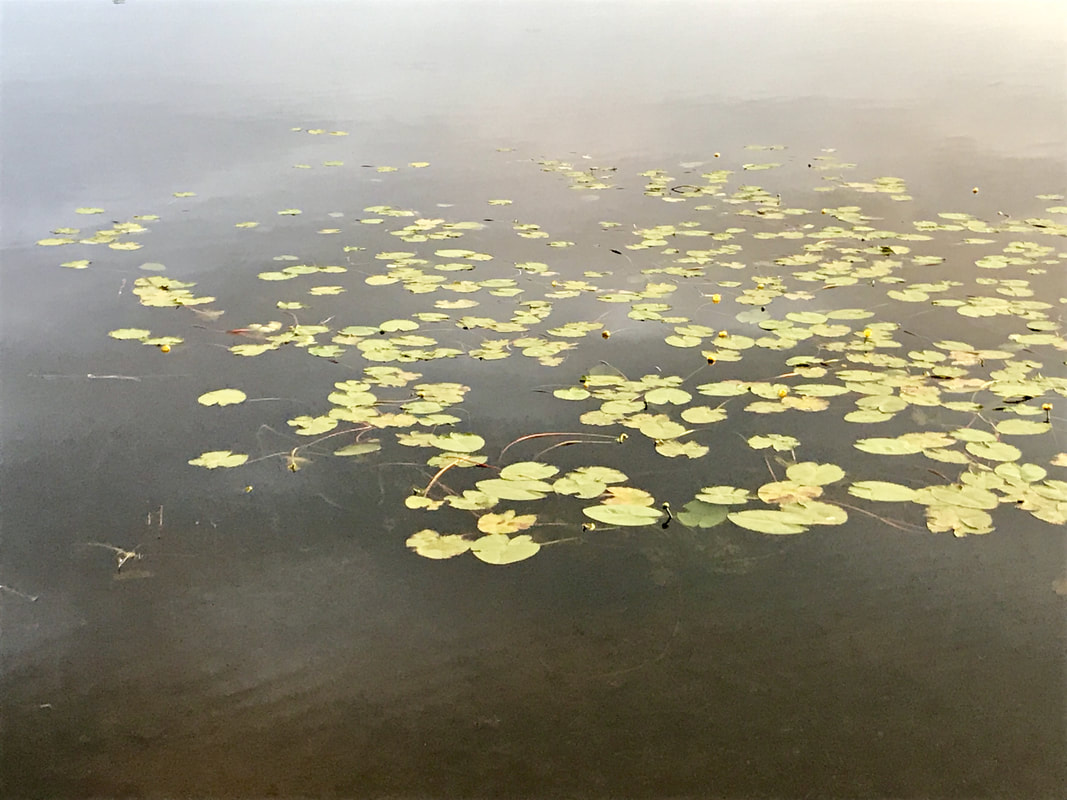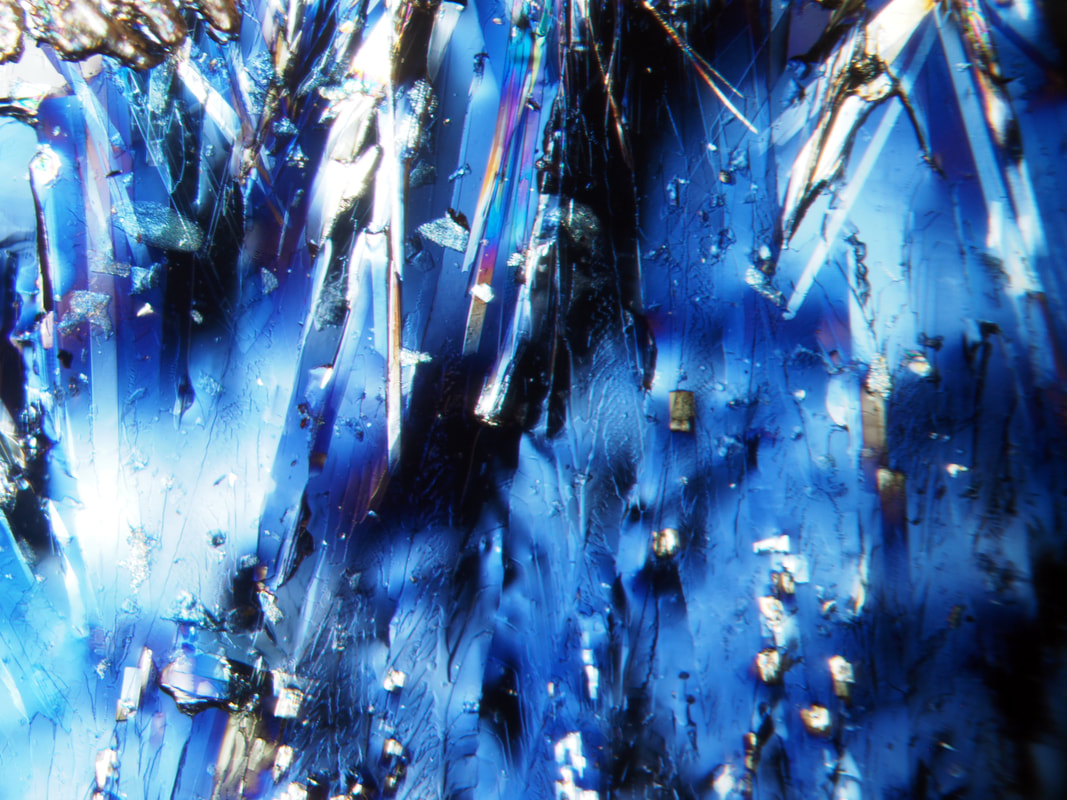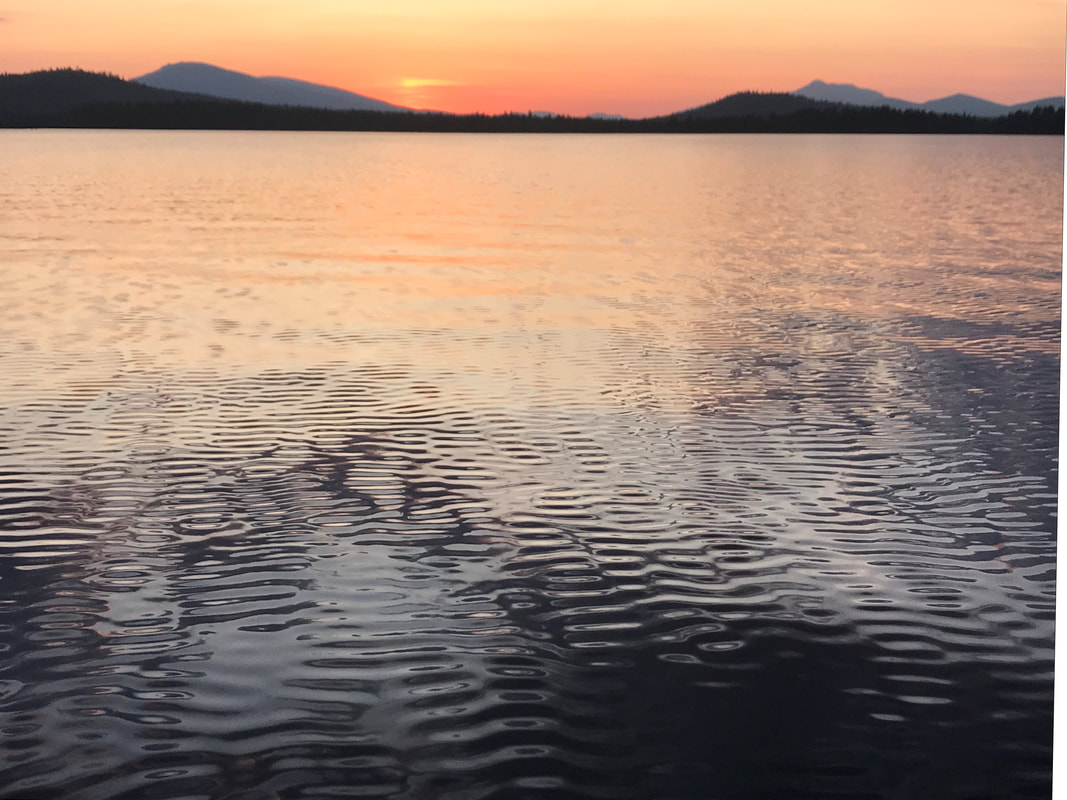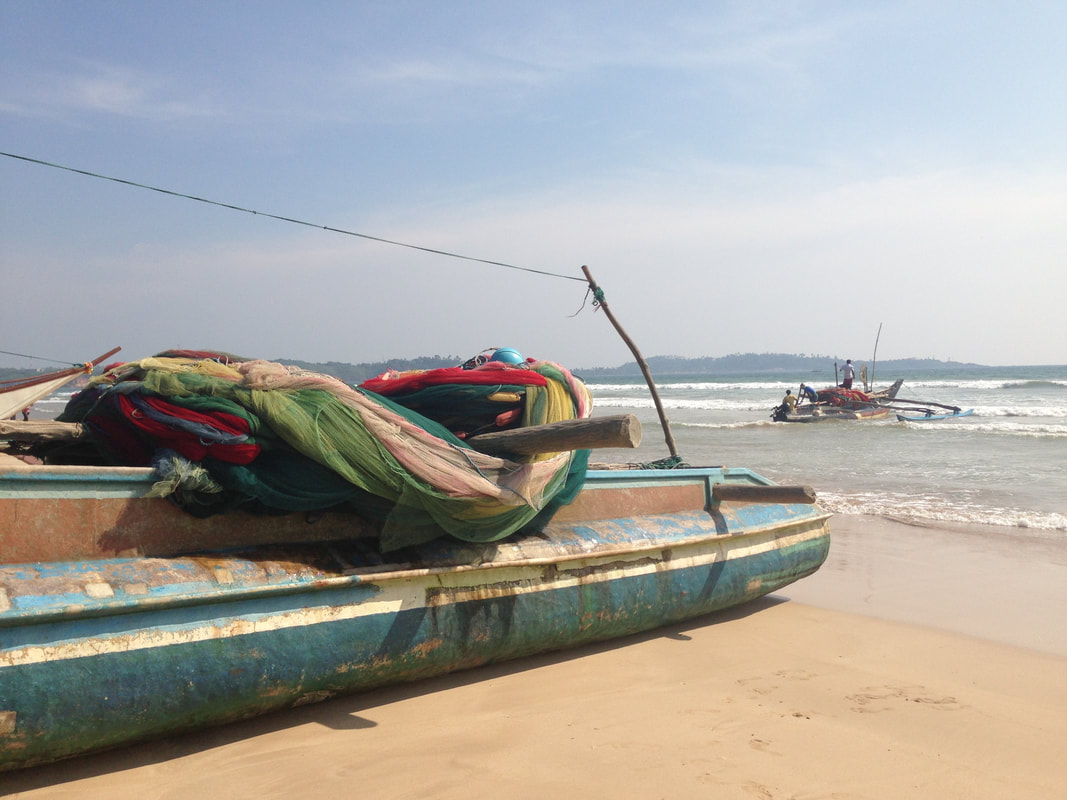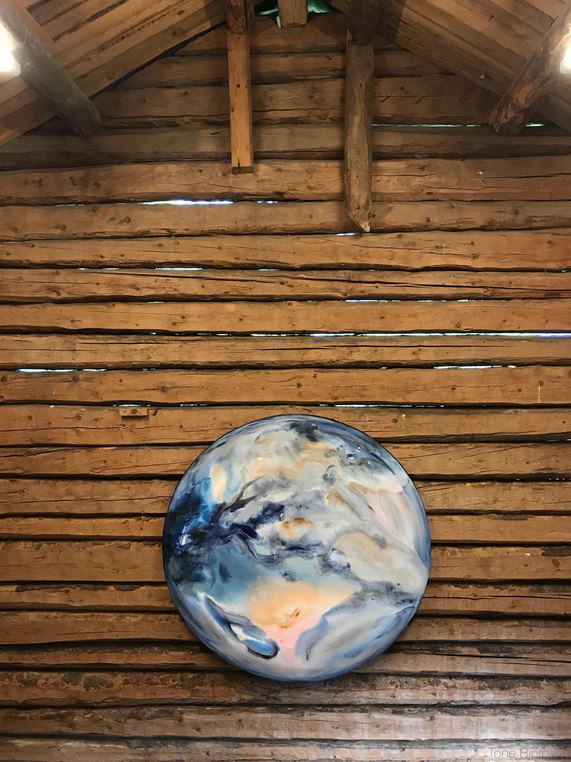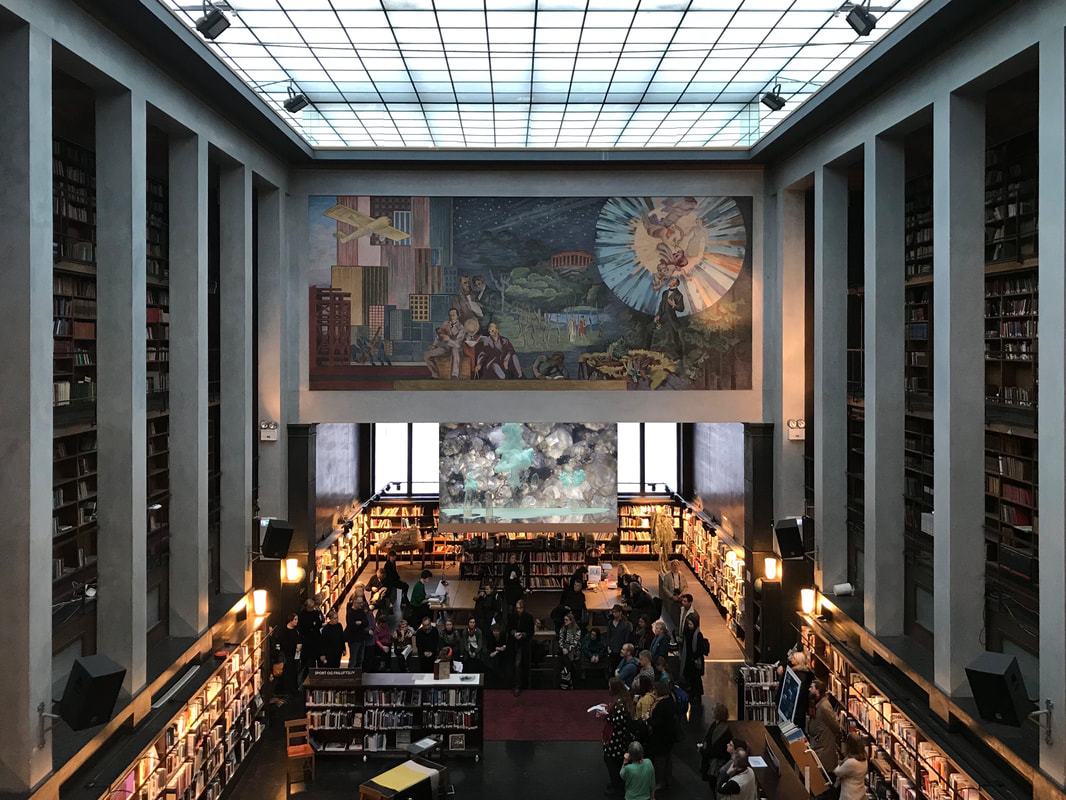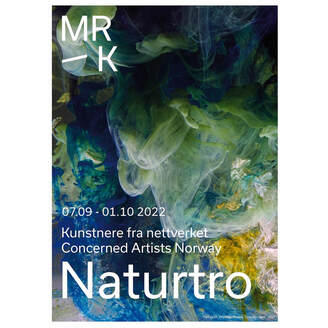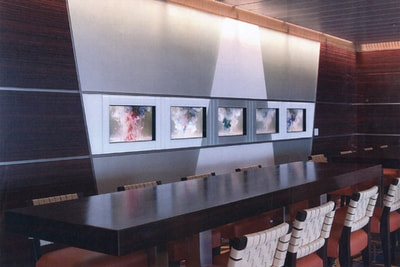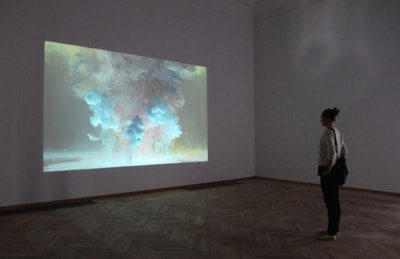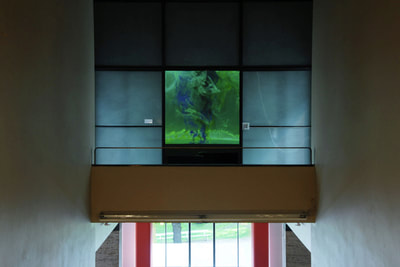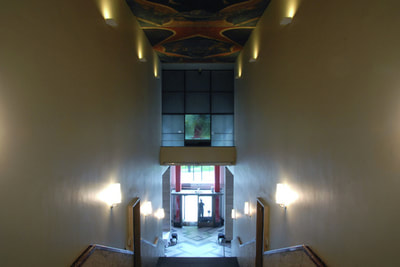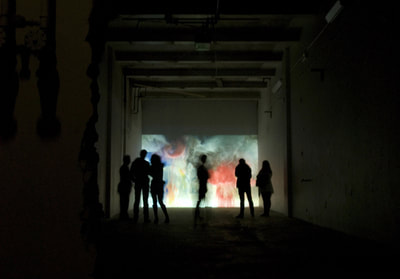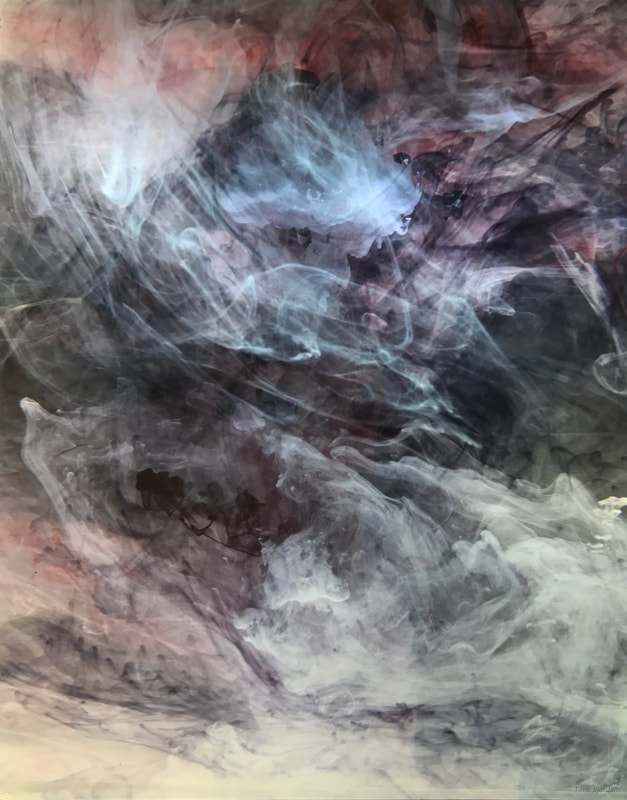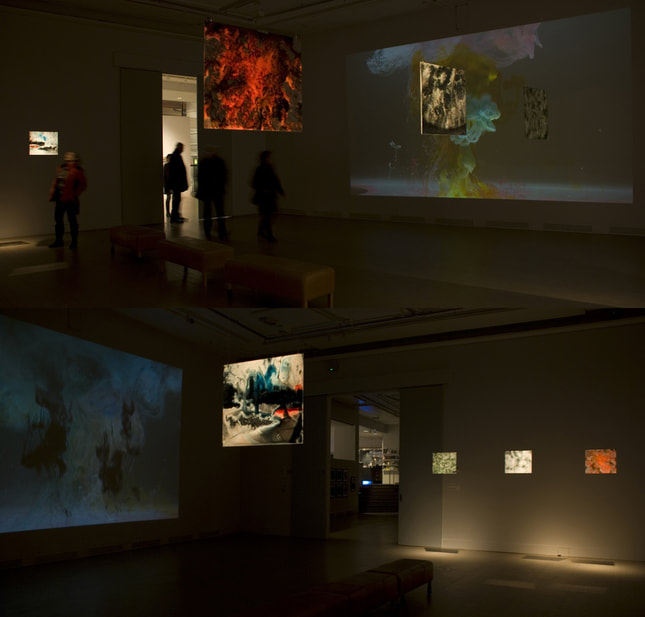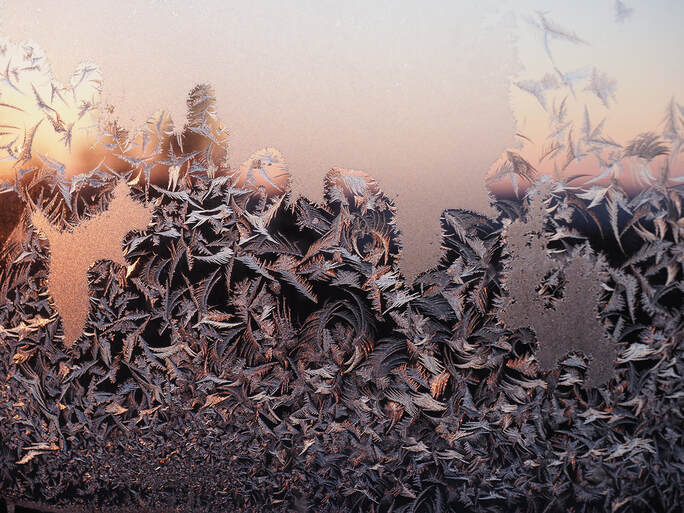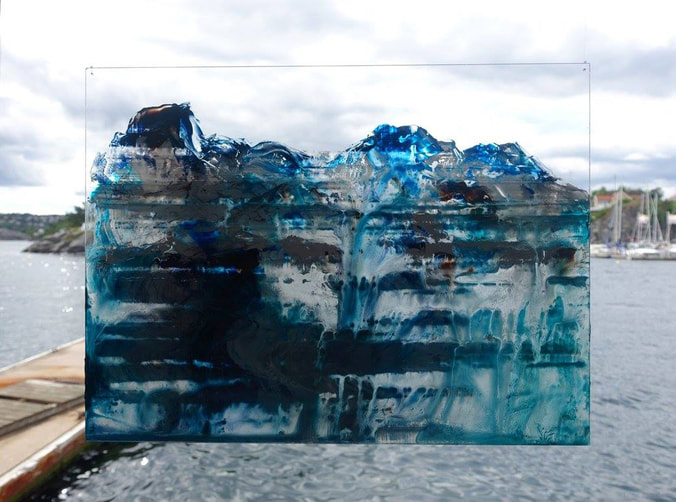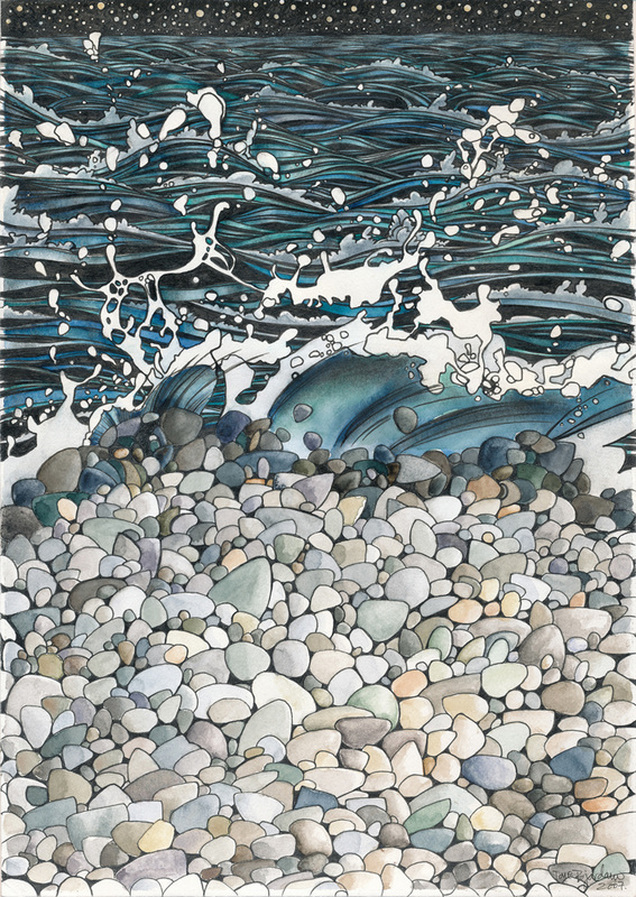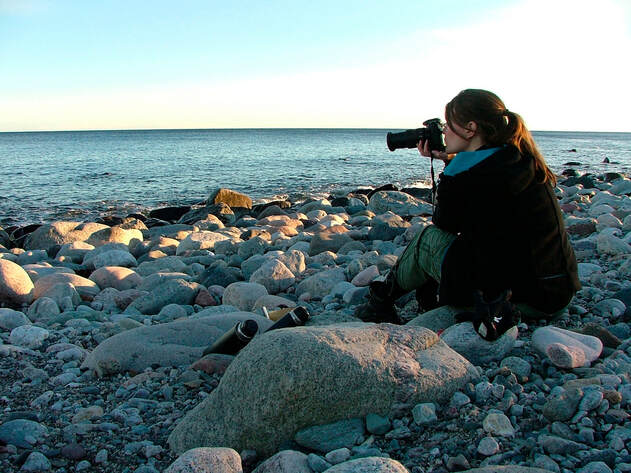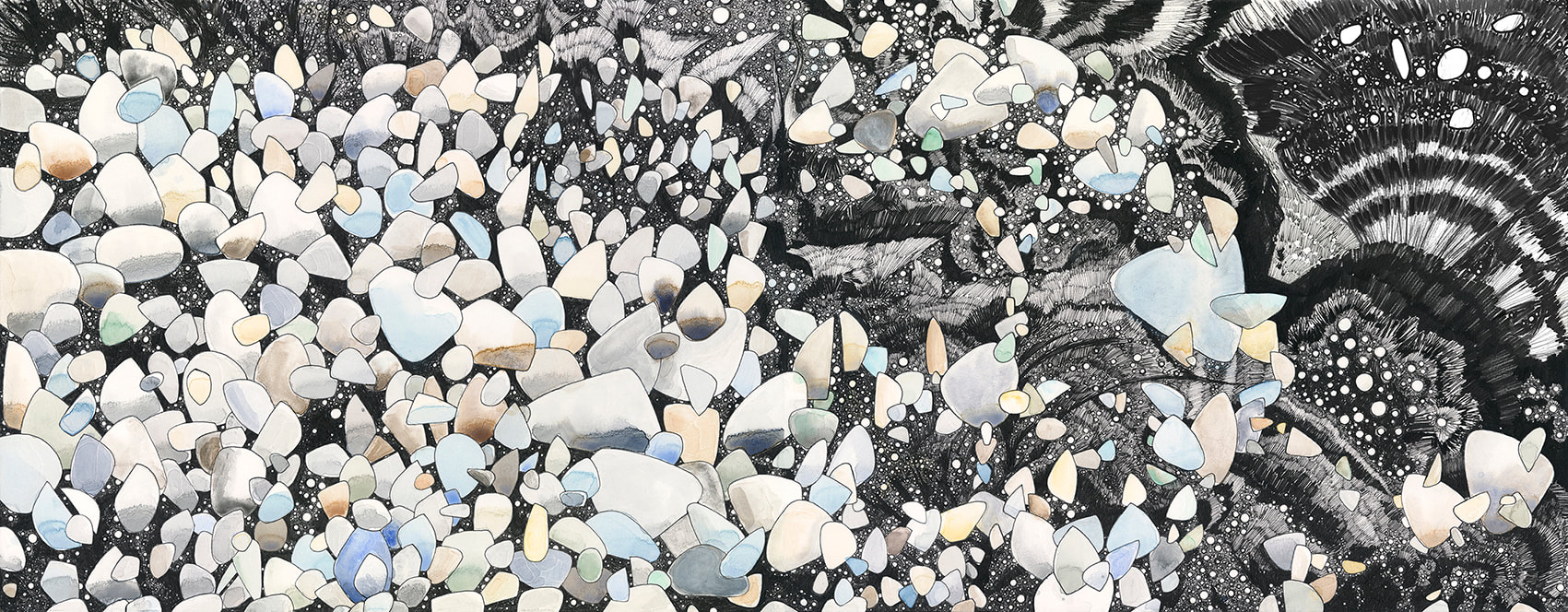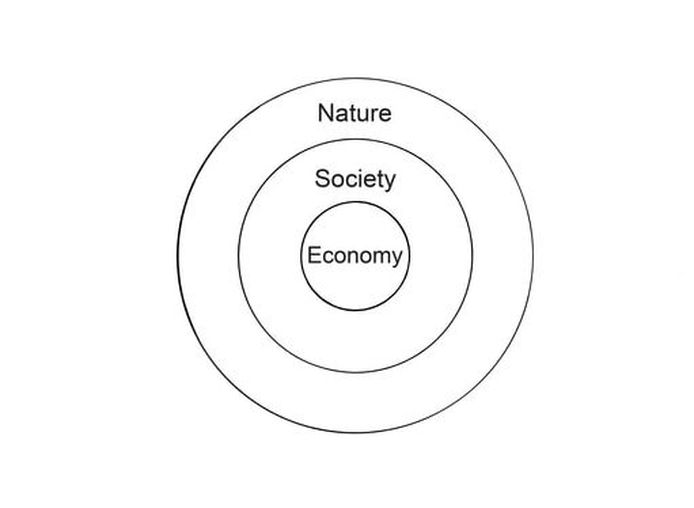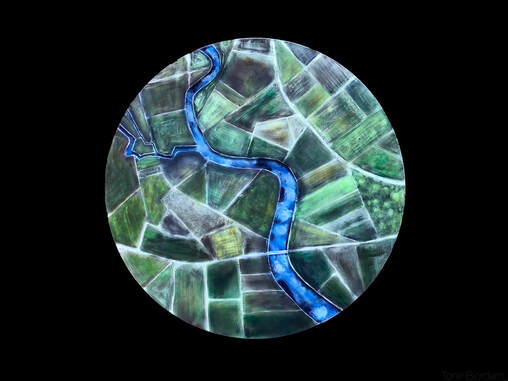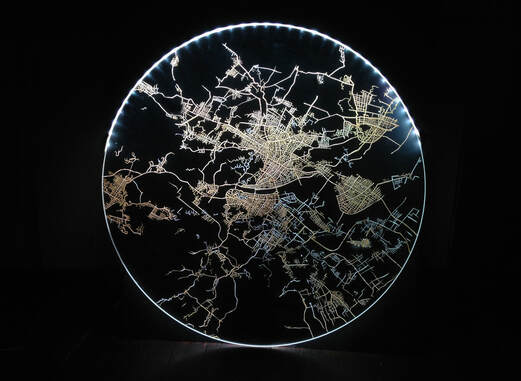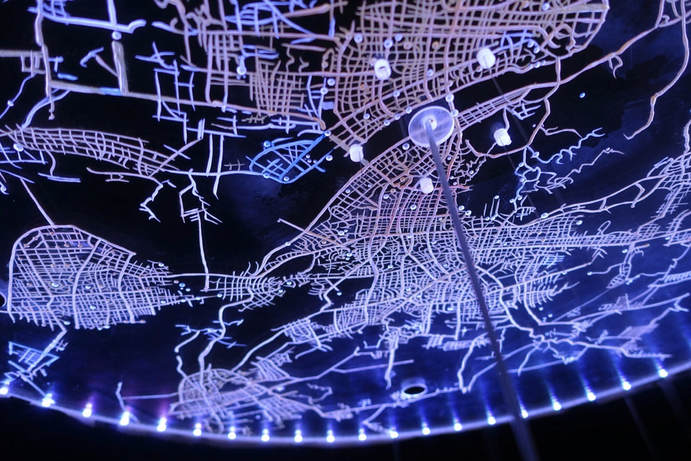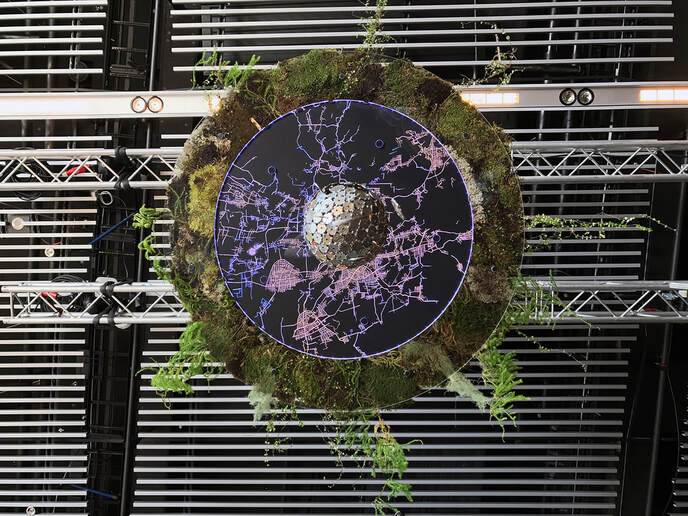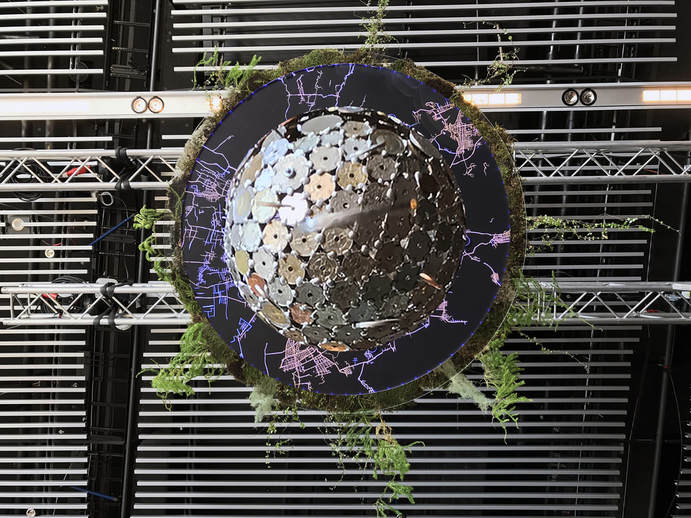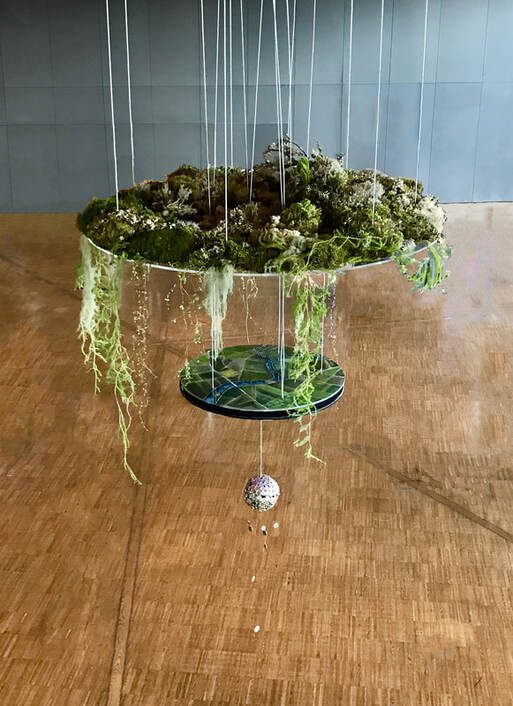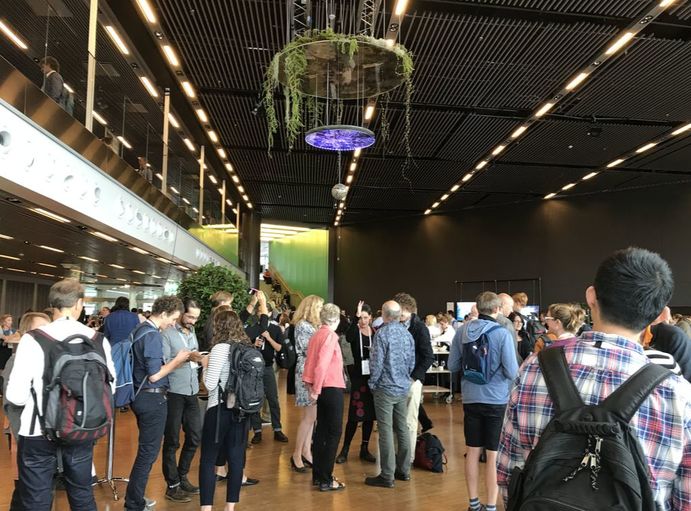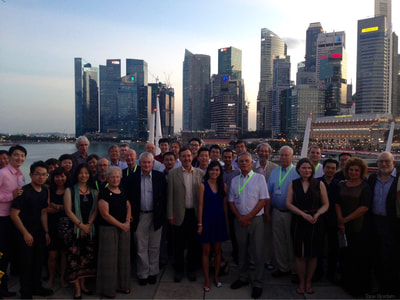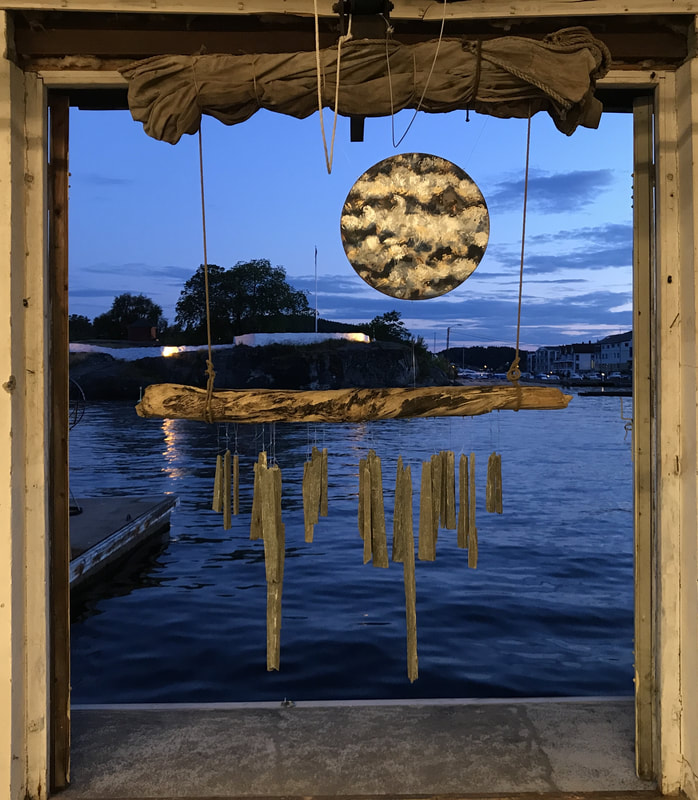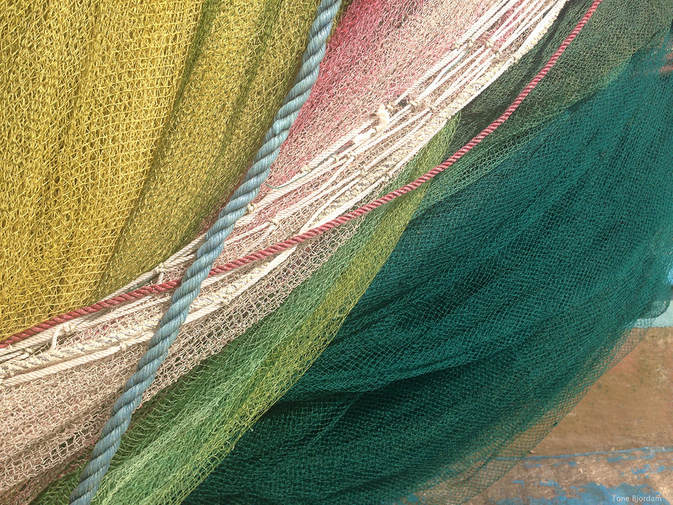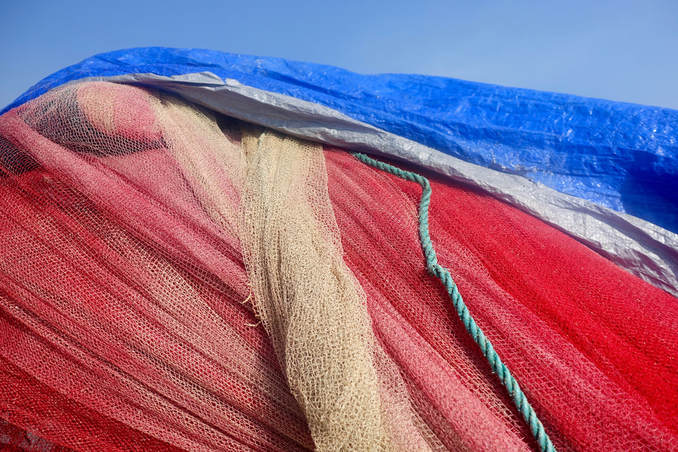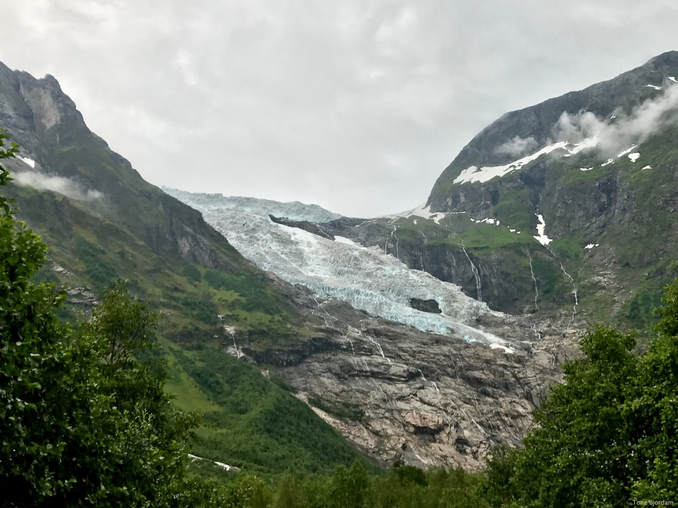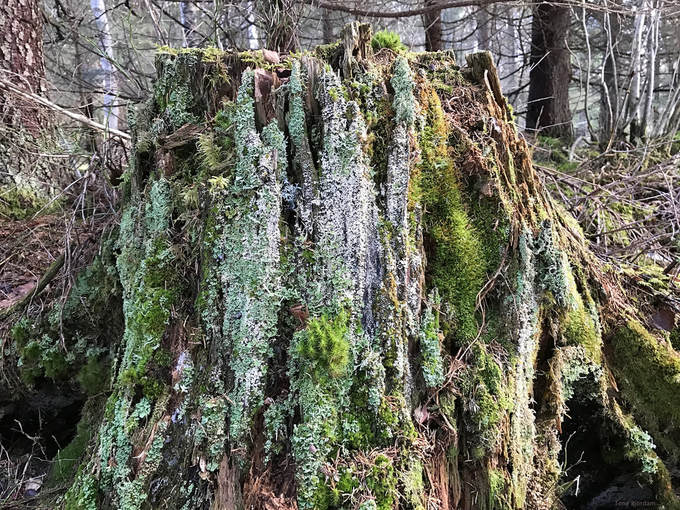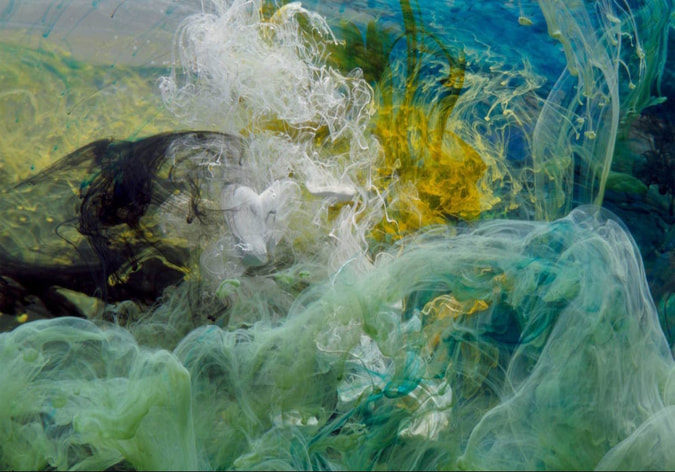Title: Filament, analog large format photography, 150 x 120 cm, Tone Bjordam, 2007
Photography mounted in a lightbox integrated into the wall to make it look like a window with a view out to an imaginary landscape. Exhibited for the first time at the Master of Fine Art Graduation Show, Oslo National Academy of the Arts (KHIO), at Stenersen Art Museum in Oslo in 2007.
Photography mounted in a lightbox integrated into the wall to make it look like a window with a view out to an imaginary landscape. Exhibited for the first time at the Master of Fine Art Graduation Show, Oslo National Academy of the Arts (KHIO), at Stenersen Art Museum in Oslo in 2007.
Artist Tone Bjordam
Transformation in nature, changes in society and in the human mind: geological, climatic and biological processes are central aspects of my artistic practice. I explore forms, patterns and processes in nature, in micro and macro perspectives.
I work with video and performance, photography, drawing, painting, soundscapes and sculpture installations.
Transformation in nature, changes in society and in the human mind: geological, climatic and biological processes are central aspects of my artistic practice. I explore forms, patterns and processes in nature, in micro and macro perspectives.
I work with video and performance, photography, drawing, painting, soundscapes and sculpture installations.
A short introduction to some of my video art, previews 2005-2023, 1 min:
Video and water soundscape: Tone Bjordam
Music: Marten Scheffer
Music: Marten Scheffer
Ongoing Projects:
My video project Sea Allegory is exhibited at Deichman Bjørvika, the main library in Oslo, 20 April - 1 September 2024
3. and 4. Origin, sculpture installation with rocks and minerals, on the wall; Glow, large format photography, Tone Bjordam, 2024
All the stones in the installation come from my grandparents, Magdalena and Olav Bjordam's mineral collection. My childhood in the forest, among stones, minerals and stories about geology and processes of transformation in nature, has greatly influenced my artistry. The glittering orange rock is a sunstone found in the bedrock at Bjordam Farm.
All the stones in the installation come from my grandparents, Magdalena and Olav Bjordam's mineral collection. My childhood in the forest, among stones, minerals and stories about geology and processes of transformation in nature, has greatly influenced my artistry. The glittering orange rock is a sunstone found in the bedrock at Bjordam Farm.
5. and 6. Woodland, large format photography, Tone Bjordam, 2024
7. and 8. Timbre, sound sculptures made of rocks and driftwood, Tone Bjordam, 2024
Raet, ink drawing and watercolour, Tone Bjordam, 2010/2024. Inspired by the moraine from the last ice age, of pebbles and sand, following the Norwegian eastern coastline.
The ever-changing movement of water and rocks, sea-plants and the abstract formations, sometimes also resembling outer space, astroids, stardust.
Folded, rock from Breheimen, found object, Tone Bjordam, 2010
Raet, ink drawing and watercolour, Tone Bjordam, 2010/2024. Inspired by the moraine from the last ice age, of pebbles and sand, following the Norwegian eastern coastline.
The ever-changing movement of water and rocks, sea-plants and the abstract formations, sometimes also resembling outer space, astroids, stardust.
Folded, rock from Breheimen, found object, Tone Bjordam, 2010
9. - 12. Flow, painting in window, site specific installation, Tone Bjordam, 2024
13. and 14. Eco, sculpture installation, forest floor, painting, engraved lines in the glass lit up with LED-lights, sphere of international coins, mixed media, Tone Bjordam, first version 2016, this version 2024. Currently exhibited in the staircase at Bomuldsfabriken Kunsthall. This sculpture installation is based on a nested sustainability diagram, showing that society and economy are dependent on natural systems and thriving ecosystems to exist. The title refers to the Greek origin of the word "eco" meaning home. For more information about this specific work, scroll to the end of this page.
You can read the catalogue text by Ragnhild Aamås here: Flow catalogue text
Reflection, (images above) and Synchron (below), Bjordam & Asplind, 2023-ongoing
A video, dance, , sculpture, performance project in collaboration with dancer and choreographer Anna Asplind
A video, dance, , sculpture, performance project in collaboration with dancer and choreographer Anna Asplind
I have delivered film material to the international film Poor Things by director Yorgos Lanthimos (The Favourite, The Lobster). These still images are from two of the chapter cards in the film with some of my liquid art elements in the background. The film won the Golden Lion at the 80th Venice Film Festival in September 2023, was nominated in 11 Oscar categories, including best film and is currently in cinema theatres world wide. 'Poor Things' won 4 Oscars on March 10 2024, including production design.
Recent projects:
Present Nature
June 17 - August 27 2023
Group exhibition at Alma Löv Museum of Unexpected Art in Värmland, Sweden
Pictures from the catalogue:
June 17 - August 27 2023
Group exhibition at Alma Löv Museum of Unexpected Art in Värmland, Sweden
Pictures from the catalogue:
Catalogue text by Jessica Kempe for the group exhibition Present Nature at Alma Löv Museum of Unexpected Art in Sweden 2023:
Nature from the depths
On the phone, Tone Bjordam sings a Norwegian folk song to me. The voice rises from the depths, with range in the timbre. "I enjoy dancing too", she says. Tone Bjordam sings like her video-recorded water paintings look. It isn’t easy at the beginning to understand how the colour installations are made. In the Rococo Cinema here at Alma Löv, the enchantment has already begun through projections and photographs, set to music by ecologist and composer, Marten Scheffer.
The method used is actually quite simple. Fundamentally, an illuminated, transparent container is filled with water. Like an aquarium. Sometimes equipped with a background image. It is when the colour pigments are dripped into the water that the painting begins. As natural pigments and inks slowly sink to the bottom, a chain of formations unfold. Abstract expressionism live. Miracle? Not yet. The transformation occurs when the entire process is videotaped upside down.
With the movement directed upwards, from the depth to the surface, the sequence of images flows straight towards nature. And art history. I see trees, plants and organisms in dramatic change, cascades of steam, light and ash, eruption of smoke and fire. Delightful vitality and dystopian destruction. Artists such as Peder Balke, Hilma af Klint and Gerhard Richter echo in the background. But Tone Bjordam also resembles the video artist Pippilotti Rist.
No wonder that Marten Scheffer saw in Tone Bjordam's painting installations an artistic relative to his own research on the climate crises and transformations in nature. Together, they have participated in a series of climate conferences and built bridges between visual arts, science, and music.
"I haven't studied natural science, but I'm good at systems and structures," Tone Bjordam answers when I wonder where her visual world comes from. From a mineral kingdom, a forest, and a lake, she tells me, where she collected patterns as a child. A treasure hunt. On the family farm, the rare mineral ‘sunstone’ was discovered. Geologists from all over the world went there to examine the stone's orange-glittering core.
Here at Alma Löv, Tone Bjordam's textile and sculptural studies of lichens and crystals are shown. In the blue container pavilion, you’ll find her microscope, for a closeup look at the universe.
Nature from the depths
On the phone, Tone Bjordam sings a Norwegian folk song to me. The voice rises from the depths, with range in the timbre. "I enjoy dancing too", she says. Tone Bjordam sings like her video-recorded water paintings look. It isn’t easy at the beginning to understand how the colour installations are made. In the Rococo Cinema here at Alma Löv, the enchantment has already begun through projections and photographs, set to music by ecologist and composer, Marten Scheffer.
The method used is actually quite simple. Fundamentally, an illuminated, transparent container is filled with water. Like an aquarium. Sometimes equipped with a background image. It is when the colour pigments are dripped into the water that the painting begins. As natural pigments and inks slowly sink to the bottom, a chain of formations unfold. Abstract expressionism live. Miracle? Not yet. The transformation occurs when the entire process is videotaped upside down.
With the movement directed upwards, from the depth to the surface, the sequence of images flows straight towards nature. And art history. I see trees, plants and organisms in dramatic change, cascades of steam, light and ash, eruption of smoke and fire. Delightful vitality and dystopian destruction. Artists such as Peder Balke, Hilma af Klint and Gerhard Richter echo in the background. But Tone Bjordam also resembles the video artist Pippilotti Rist.
No wonder that Marten Scheffer saw in Tone Bjordam's painting installations an artistic relative to his own research on the climate crises and transformations in nature. Together, they have participated in a series of climate conferences and built bridges between visual arts, science, and music.
"I haven't studied natural science, but I'm good at systems and structures," Tone Bjordam answers when I wonder where her visual world comes from. From a mineral kingdom, a forest, and a lake, she tells me, where she collected patterns as a child. A treasure hunt. On the family farm, the rare mineral ‘sunstone’ was discovered. Geologists from all over the world went there to examine the stone's orange-glittering core.
Here at Alma Löv, Tone Bjordam's textile and sculptural studies of lichens and crystals are shown. In the blue container pavilion, you’ll find her microscope, for a closeup look at the universe.
Some pictures from my part of the exhibition:
Trajectories video performance at Louisiana
I did the opening act of the art and science conference Imagine Earth, in collaboration with scientist and musician Marten Scheffer, on June 8 2023,
at Louisiana Museum of Modern Art, Humlebæk, Denmark
I did the opening act of the art and science conference Imagine Earth, in collaboration with scientist and musician Marten Scheffer, on June 8 2023,
at Louisiana Museum of Modern Art, Humlebæk, Denmark
Text from the conference program at Louisiana:
The opening act of the conference Imagine Earth is a performance by artist Tone Bjordam and the Dutch scientist and musician Marten Scheffer. Trajectories is inspired by the scientific article “Trajectories of the Earth System in the Anthropocene” (Will Steffen et al., 2018). It argues that there are two likely futures for the Earth: an ice age state or a tropical hothouse with sea-levels up to 60 metres higher than today. However, it is also possible, albeit challenging, to stabilise the benign climate that we have had for the past 10,000 years and which have allowed civilizations to emerge.
In Trajectories Bjordam creates a painting in motion. She films colours unfolding in water and projects them in real time onto a large screen. Three landscape scenarios develop in parallel: a frozen world, a hothouse Earth and – in between – a fragile but stable Earth system. Gradually, the moving landscape painting
in the video turns into abstract colour stripes representing the different scenarios: cold blue, golden green and warm orange. Scheffer plays a variety of instruments live on stage accompanying the micro universe unfolding on the screen.
The opening act of the conference Imagine Earth is a performance by artist Tone Bjordam and the Dutch scientist and musician Marten Scheffer. Trajectories is inspired by the scientific article “Trajectories of the Earth System in the Anthropocene” (Will Steffen et al., 2018). It argues that there are two likely futures for the Earth: an ice age state or a tropical hothouse with sea-levels up to 60 metres higher than today. However, it is also possible, albeit challenging, to stabilise the benign climate that we have had for the past 10,000 years and which have allowed civilizations to emerge.
In Trajectories Bjordam creates a painting in motion. She films colours unfolding in water and projects them in real time onto a large screen. Three landscape scenarios develop in parallel: a frozen world, a hothouse Earth and – in between – a fragile but stable Earth system. Gradually, the moving landscape painting
in the video turns into abstract colour stripes representing the different scenarios: cold blue, golden green and warm orange. Scheffer plays a variety of instruments live on stage accompanying the micro universe unfolding on the screen.
Performance in the Concert Hall at Louisiana Museum of Modern Art, June 8, 2023
Trajectories, video performance by Tone Bjordam, music by Marten Scheffer, filmed from the audience
Trajectories, video performance by Tone Bjordam, music by Marten Scheffer, filmed from the audience
A full version recorded at Louisiana Museum of Modern Art :
The first time Trajectories was performed was at ECCA
(European Climate Change Adaption) Conference 2019 at CCB, Centro Cultural de Belém, Lisbon, Portugal. Tone Bjordam (live video) and Marten Scheffer (music), 2019
(European Climate Change Adaption) Conference 2019 at CCB, Centro Cultural de Belém, Lisbon, Portugal. Tone Bjordam (live video) and Marten Scheffer (music), 2019
To see a studio version of Trajectories without the live aspect, click here: Trajectories Studio Version
Sea Allegory, Tone Bjordam, 2023, installation with video on back projection canvas hanging on branches
Exhibited at the group exhibition Video XVI at Kunstrum Fyn, Denmark, October, 2023
Exhibited at the group exhibition Video XVI at Kunstrum Fyn, Denmark, October, 2023
Background
I come from the farm ‘Bjordam’ which is located in the forest on the border between Bamble and Kragerø in Telemark, Norway. My family has worked and traded with rocks and minerals for generations, and early on I was told how crystals and various stones are formed. In the bedrock at Bjordam there is a deposit of an orange form of aventurine feldspar called sunstone. Inside the stone there are colorful, glittering lamellae of hematite, and as a child I imagined how the sunstone came into existence in a dramatic volcanic scenario millions of years ago. This early interest in the nature of change, abstract patterns and an continuous search for beauty and wonder in nature, has since greatly influenced my art.
I come from the farm ‘Bjordam’ which is located in the forest on the border between Bamble and Kragerø in Telemark, Norway. My family has worked and traded with rocks and minerals for generations, and early on I was told how crystals and various stones are formed. In the bedrock at Bjordam there is a deposit of an orange form of aventurine feldspar called sunstone. Inside the stone there are colorful, glittering lamellae of hematite, and as a child I imagined how the sunstone came into existence in a dramatic volcanic scenario millions of years ago. This early interest in the nature of change, abstract patterns and an continuous search for beauty and wonder in nature, has since greatly influenced my art.
Sunstone from Bjordam, photography, Tone Bjordam, 2020
Inside a Sunstone, photomicrography, Tone Bjordam, 2022
Plasma, detail, large format photography of ink and water mounted in a lightbox, Tone Bjordam, 2007
Calcite, photography, Tone Bjordam, 2007. First exhibited in a lightbox mounted in a window in 2008 at solo exhibition Night Sky View, curated by Marthe Walthinsen, in the tower at Galleri Trafo, Asker, Norway. These crystals are from a huge underground limestone mine nearby Bjordam farm. I captured this image amongst thousands of rocks and crystals in my family's mineral collection.
About my work
My studio is in a large and bright attic in an old timber building located in Nordmarka in the forest outside Oslo. In my daily artistic practice, I often film and photograph outside in nature: moving water and clouds, ice and rock formations, the forest through changing seasons and moss and lichen reminiscent of miniature landscapes. Through this material, I collect patterns and shapes, which I then seek to refine using various techniques. The results of this exploratory and continuous way of working, and the artistic branches of work that arise, are important components in the art I create. In the wintertime, sculptural icicles adorn the windows in the attic, and in the summer months, the forest outside gives easy access to inspiration, materials and motives.
Here are some photographs I've taken outside my studio:
My studio is in a large and bright attic in an old timber building located in Nordmarka in the forest outside Oslo. In my daily artistic practice, I often film and photograph outside in nature: moving water and clouds, ice and rock formations, the forest through changing seasons and moss and lichen reminiscent of miniature landscapes. Through this material, I collect patterns and shapes, which I then seek to refine using various techniques. The results of this exploratory and continuous way of working, and the artistic branches of work that arise, are important components in the art I create. In the wintertime, sculptural icicles adorn the windows in the attic, and in the summer months, the forest outside gives easy access to inspiration, materials and motives.
Here are some photographs I've taken outside my studio:
Left: Halo, photography of an optical phenomenon called Parry arc, a halo produced by light interacting with tiny ice crystals suspended in the atmosphere, Tone Bjordam, 2020
Right: Stratosphere, photography of polar stratospheric mother-of-pearls clouds, Tone Bjordam, 2020
Right: Stratosphere, photography of polar stratospheric mother-of-pearls clouds, Tone Bjordam, 2020
Polar, photography of stratospheric mother-of-pearls clouds, Tone Bjordam, 2023
Water States, nature photography of a cloud, liquid water and a thin ice sheet from a frozen lake, Tone Bjordam, 2020
Water Lily, photography, Tone Bjordam 2021
Icicles, photography, Tone Bjordam, 2021
Paintings in motion and liquid landscapes
Since 2004, I have been working on projects where I photograph and film the movement and course of liquid ink and paint. At a meditative pace, the viewer is confronted with cascades of colors and pigments that unfold in water. I drip paint, ink and other colored liquids into large water tanks and film the process along the way. I also use other materials, such as dry pigments, moss, lichen, plants and twigs, stones and crystals. In the background of the video, I put up paintings, photographs and stones that layer upon layer create depth in the scene that is taking place in front of the camera. The videos look like abstract paintings in motion, with allusions to chemical processes, romantic and atmospheric landscape paintings, cloud formations and climatic processes. I plan the narratives in the videos carefully in advance with sketches, and by experimenting with different liquids and categorizing them according to their special properties. Although I work in a controlled manner, there are many coincidences that happen just by chance during the process; this often adds to the dynamics and the narrative of the animated video painting that occurs. I then combine the finished video material with traditional or experimental music or soundscapes that I record in nature, like water, wind or birdsong.
I started using this technique while I was a student at the Art Academy in Oslo (2001-2007) and these works were first exhibited through the video project Liquid Landscape at Oslo Art Academy's Diploma Graduation Exhibition (KHIO) in 2005. From what looks like a vast ocean, a swirling landscape appears from the horizon and a cloudy weather system builds up around it. I also worked with photography and went on to produce a series of analogue large format photographs, some of them were exhibited in light boxes at Oslo Art Academy's Master Graduation Exhibition (KHIO) in 2007, at the Stenersen Art Museum in Oslo. Since then, I have developed the technique over many years through a series of video and photography projects. In these works, I explore painting as a medium, through both abstract and naturalistic expressions. The video Liquid Landscape (2005), is installed as a public installation at Stavanger University, Norway, and in 2018 - 2019 it was exhibited at a large art and science exhibition with work related to physics and fluid dynamics entitled Wunderkammer, at Esbjerg Art Museum in Denmark.
Since 2004, I have been working on projects where I photograph and film the movement and course of liquid ink and paint. At a meditative pace, the viewer is confronted with cascades of colors and pigments that unfold in water. I drip paint, ink and other colored liquids into large water tanks and film the process along the way. I also use other materials, such as dry pigments, moss, lichen, plants and twigs, stones and crystals. In the background of the video, I put up paintings, photographs and stones that layer upon layer create depth in the scene that is taking place in front of the camera. The videos look like abstract paintings in motion, with allusions to chemical processes, romantic and atmospheric landscape paintings, cloud formations and climatic processes. I plan the narratives in the videos carefully in advance with sketches, and by experimenting with different liquids and categorizing them according to their special properties. Although I work in a controlled manner, there are many coincidences that happen just by chance during the process; this often adds to the dynamics and the narrative of the animated video painting that occurs. I then combine the finished video material with traditional or experimental music or soundscapes that I record in nature, like water, wind or birdsong.
I started using this technique while I was a student at the Art Academy in Oslo (2001-2007) and these works were first exhibited through the video project Liquid Landscape at Oslo Art Academy's Diploma Graduation Exhibition (KHIO) in 2005. From what looks like a vast ocean, a swirling landscape appears from the horizon and a cloudy weather system builds up around it. I also worked with photography and went on to produce a series of analogue large format photographs, some of them were exhibited in light boxes at Oslo Art Academy's Master Graduation Exhibition (KHIO) in 2007, at the Stenersen Art Museum in Oslo. Since then, I have developed the technique over many years through a series of video and photography projects. In these works, I explore painting as a medium, through both abstract and naturalistic expressions. The video Liquid Landscape (2005), is installed as a public installation at Stavanger University, Norway, and in 2018 - 2019 it was exhibited at a large art and science exhibition with work related to physics and fluid dynamics entitled Wunderkammer, at Esbjerg Art Museum in Denmark.
Liquid Landscape, still image from video, Tone Bjordam, 2005
Video Portfolio with previews of some of my work, 15 min:
Lichen Landscapes, photography series, Tone Bjordam, 2020-2021
Images from my exhibition Morf, Transformations in Lichen Landscapes at Kunstbanken in Hamar 2022
2022 Morph - Transformations in Lichen Landscapes, solo exhibition, May 21 - August 7 2022 at Kunstbanken, Hedmark Kunstsenter, Hamar, Norway
About the exhibition Morf:
Video projections are exhibited in combination with photographs on glass in light boxes and installations of forest floor, rocks and minerals.
The term morph comes from the ancient Greek word morphḗ which means form, and refers to processes where something gradually changes from one state to another. In old-growth forests, organic material is converted in several rounds, as nutrition for a large number of organisms.
In the photography series Morf and Lichen Landscapes (2021 and 2022) we see bustling biological diversity on old stumps, uprooted trees and in organic materials in an old forest close to Hamar where the exhibition takes place. Miniature landscapes with moss and lichen emerge in shimmering light filtered between the trees.
Intricate symbiosis and connections between lichens, algae, fungi, insects, moss and wood can be observed in detail in this series of photographs. Old forest purifies air, stores carbon and is a natural habitat for a diversity of species. Continuous processes, both visible and hidden from the human eye, are ongoing and vital to the balance of nature and our existence. In Norway, there is now only around 2,4 percent left of proper old-growth forest; that is, forests that has attained great age without significant disturbance, at least for 160 years or more.
The video Seasonal Transitions (2021) is inspired by the gradual transitions of the seasons going from one state to another. The video joins a series of works on transformation that began with the video Critical Transitions (2012). In Seasonal Transitions, the soundtrack follows the changing seasons with recordings I have made in the forest in Nordmarka. The soundscape consists of recordings of icicles, rocks and drizzling snow crystals, gentle sounds of water in a river flowing by, lynx cries in spring, owls and birdsong. There is also music by scientist and musician Marten Scheffer, with Arthur Bont on percussion. The video works as an animated video painting and it is an exploration of natural pigments and ink as substance.
About the exhibition Morf:
Video projections are exhibited in combination with photographs on glass in light boxes and installations of forest floor, rocks and minerals.
The term morph comes from the ancient Greek word morphḗ which means form, and refers to processes where something gradually changes from one state to another. In old-growth forests, organic material is converted in several rounds, as nutrition for a large number of organisms.
In the photography series Morf and Lichen Landscapes (2021 and 2022) we see bustling biological diversity on old stumps, uprooted trees and in organic materials in an old forest close to Hamar where the exhibition takes place. Miniature landscapes with moss and lichen emerge in shimmering light filtered between the trees.
Intricate symbiosis and connections between lichens, algae, fungi, insects, moss and wood can be observed in detail in this series of photographs. Old forest purifies air, stores carbon and is a natural habitat for a diversity of species. Continuous processes, both visible and hidden from the human eye, are ongoing and vital to the balance of nature and our existence. In Norway, there is now only around 2,4 percent left of proper old-growth forest; that is, forests that has attained great age without significant disturbance, at least for 160 years or more.
The video Seasonal Transitions (2021) is inspired by the gradual transitions of the seasons going from one state to another. The video joins a series of works on transformation that began with the video Critical Transitions (2012). In Seasonal Transitions, the soundtrack follows the changing seasons with recordings I have made in the forest in Nordmarka. The soundscape consists of recordings of icicles, rocks and drizzling snow crystals, gentle sounds of water in a river flowing by, lynx cries in spring, owls and birdsong. There is also music by scientist and musician Marten Scheffer, with Arthur Bont on percussion. The video works as an animated video painting and it is an exploration of natural pigments and ink as substance.
Lift, microphotography, 2020, Sva, photography of geological formation, 2010, Tracks, microphotography, Tone Bjordam, 2020
The poster, image and video above are from the group show As far as my Eyes can Sea – The Expedition Exhibition, at Bomuldsfabriken Kunsthall in Arendal June-September 2021. The REV Ocean Art collection will be installed onboard the scientific research vessel REV Ocean, and curators behind the exhibition was Åse Kamilla Spjelkavik Aslaksen and Tone Lyngstad Nyaas. The exhibition consisted of 135 works of art, amongst them 3 of my videos: Coral (2009), Domedagslåtten (2017) and Moving Matter (2018).
Interstellar, photography of pigments, ink and water, Tone Bjordam, 2020
Series of large format photographs, Tone Bjordam, 2007
Click on images to enlarge
Click on images to enlarge
Coral, still images from video, 12 min loop, Tone Bjordam, 2009
Coral
In 2009 I made a video entitled Coral. In contrast to the dark, mostly black and white Liquid Landscape, Coral is bright and colourful. The pigments that emerge from the water surface slowly appear to assume shapes reminiscent of organic forms such as plants, blooming flowers and of smoke, mountains, volcanic activity, explosions, clouds and as the title suggests, corals.
In 2010 Coral was exhibited at Carnegie Art Award, a group exhibition focusing on painting in contemporary art, touring major art museums in the Nordic countries: Kunsthal Charlottenborg in Copenhagen, Denmark, Kunsthalle Helsinki, Finland, Kungliga Konstkademien in Stockholm, Sweden, Iceland National Gallery in Reykjavik, Iceland and Kunstnernes Hus in Oslo, Norway. During the exhibition period the audience could vote for their favourite art project and Coral won the People's Choice Award in all the venues the Carnegie Art Award 2010 exhibition was shown. It's been exhibited at In Your Face, Galleri 7011, Trondheim, Norway, Exotic, an international video and installation exhibition, Tallinn Art Hall, Estonia 2012 and at Vestlandsutstillingen in 2012. Coral is a part of Stavanger Art Museum’s art collection. Three permanent public video installations purchased through ICArt are onboard the ship Equinox, Royal Art Caribbean. Public installations also at INSPIRIA Science Centre, Grålum, Norway, onboard the REV Ocean Scientific Research Vessel and at United Nations University, Institute for Environment and Human Security located in the UN building in Bonn, Germany.
In 2009 I made a video entitled Coral. In contrast to the dark, mostly black and white Liquid Landscape, Coral is bright and colourful. The pigments that emerge from the water surface slowly appear to assume shapes reminiscent of organic forms such as plants, blooming flowers and of smoke, mountains, volcanic activity, explosions, clouds and as the title suggests, corals.
In 2010 Coral was exhibited at Carnegie Art Award, a group exhibition focusing on painting in contemporary art, touring major art museums in the Nordic countries: Kunsthal Charlottenborg in Copenhagen, Denmark, Kunsthalle Helsinki, Finland, Kungliga Konstkademien in Stockholm, Sweden, Iceland National Gallery in Reykjavik, Iceland and Kunstnernes Hus in Oslo, Norway. During the exhibition period the audience could vote for their favourite art project and Coral won the People's Choice Award in all the venues the Carnegie Art Award 2010 exhibition was shown. It's been exhibited at In Your Face, Galleri 7011, Trondheim, Norway, Exotic, an international video and installation exhibition, Tallinn Art Hall, Estonia 2012 and at Vestlandsutstillingen in 2012. Coral is a part of Stavanger Art Museum’s art collection. Three permanent public video installations purchased through ICArt are onboard the ship Equinox, Royal Art Caribbean. Public installations also at INSPIRIA Science Centre, Grålum, Norway, onboard the REV Ocean Scientific Research Vessel and at United Nations University, Institute for Environment and Human Security located in the UN building in Bonn, Germany.
Interview with Tone Bjordam from 2009
Made by Swedish TV in connection with the Carnegie Art Award Exhibition 2010:
Made by Swedish TV in connection with the Carnegie Art Award Exhibition 2010:
1. Portrait of Tone Bjordam's reflection in a pond in the forest by photographer Javier Auris for Norwegian newspaper Klassekampen, 2017
2. Tone presenting art at the conference Silent Transformations at Nanyang Technological University in Singapore, March 2016
3. Tone in her studio, December 2020
2. Tone presenting art at the conference Silent Transformations at Nanyang Technological University in Singapore, March 2016
3. Tone in her studio, December 2020
A short preview of Coral (2009):
Scientific research and collaboration
Stockholm Resilience Center had a conference dinner at the art museum when the Carnegie Art Award Exhibition was shown in Stockholm in 2010. In attendance was Marten Scheffer, a professor of ecology and mathematical biology at the University of Wageningen in the Netherlands. On seeing my work, he felt that we shared a common interest in wanting to convey ideas around systems and natural environments that gradually change. Marten's work is primarily focused on ecosystems in lakes, but he is also a bridge-builder in the science world and has worked with a number of scientists from different disciplines. He studies stability and tipping points and seeks to mathematically predict sudden changes in complex natural and social systems, such as the collapse of ancient societies with parallels to our time, changes in public opinion, economic upheavals, climate change and forest dynamics.
Marten contacted me in 2011 and we started to work together. We are both interested in conveying change and upheaval of systems, and ecosystems that go from one state to another, such as a forest that becomes a desert, or a desert that gradually becomes a forest. Although our interests coincide, the way we have been communicating the results of the topics we both work with have been different, for my part through art projects and for Marten's part through research, books and articles. We found that by collaborating, we were able to convey the essence of these topics in new ways and gain surprising angles and insights along the way. In addition to the sensuous art experience, scientific books and articles can add several layers in the art projects, suitable for deepening the themes that the works of art draw their inspiration from.
Since 2011, I have been invited to exhibit and present art at a number of international science conferences, participated in workshops and contributed with topics and art to scientific books and articles. The collaborations work both ways. I create works of art inspired by scientific theories and, by working together with scientists, I have direct access to up-to-date knowledge. As for the scientists, they collect inspiration from the art I make and can take these ideas into their own research.
An example of this is the video Critical Transitions from 2012, where 3 systems reminiscent of landscapes build up, collapse, and then rebuild in a new system. This video is inspired by conversations with Marten Scheffer and by his book Critical Transitions in Nature and Society. Marten is also a musician and he composed and recorded all the music for the video, together with Arthur Bont on percussion. When Marten received the video material from me, he noticed how the human experience of change makes us easily preoccupied with all the tiny details in the process that takes place, rather than seeing the bigger picture, and that responding effectively to change is then often delayed. Human reaction patterns - and perception in relation to changing systems - was something that he then began to emphasize more in research projects and including in his mathematical calculations.
Critical Transitions was first shown in 2012 in Portland, Oregon, USA at the ESA Conference 2012 (Ecological Society of America), at a solo exhibition at Galleri BOA in Oslo in 2012 and as a public installation at Oslo Central Station curated by Rom for Kunst and Oslo Screen Festival. It was shown at artArctica Festival 2015, Helsinki, Finland, at Life Art Worldwide Showcase, Brisbane, Australia and at scientific conferences in Norway, Uruguay and Singapore.
Watch a short version of the video Critical Transitions here:
Text written by Marten Scheffer. Narration by Tone Bjordam
Stockholm Resilience Center had a conference dinner at the art museum when the Carnegie Art Award Exhibition was shown in Stockholm in 2010. In attendance was Marten Scheffer, a professor of ecology and mathematical biology at the University of Wageningen in the Netherlands. On seeing my work, he felt that we shared a common interest in wanting to convey ideas around systems and natural environments that gradually change. Marten's work is primarily focused on ecosystems in lakes, but he is also a bridge-builder in the science world and has worked with a number of scientists from different disciplines. He studies stability and tipping points and seeks to mathematically predict sudden changes in complex natural and social systems, such as the collapse of ancient societies with parallels to our time, changes in public opinion, economic upheavals, climate change and forest dynamics.
Marten contacted me in 2011 and we started to work together. We are both interested in conveying change and upheaval of systems, and ecosystems that go from one state to another, such as a forest that becomes a desert, or a desert that gradually becomes a forest. Although our interests coincide, the way we have been communicating the results of the topics we both work with have been different, for my part through art projects and for Marten's part through research, books and articles. We found that by collaborating, we were able to convey the essence of these topics in new ways and gain surprising angles and insights along the way. In addition to the sensuous art experience, scientific books and articles can add several layers in the art projects, suitable for deepening the themes that the works of art draw their inspiration from.
Since 2011, I have been invited to exhibit and present art at a number of international science conferences, participated in workshops and contributed with topics and art to scientific books and articles. The collaborations work both ways. I create works of art inspired by scientific theories and, by working together with scientists, I have direct access to up-to-date knowledge. As for the scientists, they collect inspiration from the art I make and can take these ideas into their own research.
An example of this is the video Critical Transitions from 2012, where 3 systems reminiscent of landscapes build up, collapse, and then rebuild in a new system. This video is inspired by conversations with Marten Scheffer and by his book Critical Transitions in Nature and Society. Marten is also a musician and he composed and recorded all the music for the video, together with Arthur Bont on percussion. When Marten received the video material from me, he noticed how the human experience of change makes us easily preoccupied with all the tiny details in the process that takes place, rather than seeing the bigger picture, and that responding effectively to change is then often delayed. Human reaction patterns - and perception in relation to changing systems - was something that he then began to emphasize more in research projects and including in his mathematical calculations.
Critical Transitions was first shown in 2012 in Portland, Oregon, USA at the ESA Conference 2012 (Ecological Society of America), at a solo exhibition at Galleri BOA in Oslo in 2012 and as a public installation at Oslo Central Station curated by Rom for Kunst and Oslo Screen Festival. It was shown at artArctica Festival 2015, Helsinki, Finland, at Life Art Worldwide Showcase, Brisbane, Australia and at scientific conferences in Norway, Uruguay and Singapore.
Watch a short version of the video Critical Transitions here:
Text written by Marten Scheffer. Narration by Tone Bjordam
Critical Transitions, video by Tone Bjordam, music by Marten Scheffer with Arthur Bont on percussion, 2012
Transformation
The video Critical Transitions is an artistic visualisation of processes that are constantly going on around us. A system gradually builds up, and eventually it sometimes reaches a tipping point where it suddenly changes. After that, it might stabilise in a new system. In the video there are three sequences, each about 10 minutes in length, inspired by such processes. The video can be viewed as an abstract painting in motion or as a landscape in flux.
Tipping point
Climate, forests, coral reefs, financial markets and even our minds occasionally reach a tipping point where they go through a radical transformation. Foreseeing such critical transitions or even noticing that they are unfolding is challenging as they are embedded in the omnipresent permanent flow of change.
Anticipating patterns
Dazzled by myriads of such minimal motions, how can we see that they sometimes erupt into transforming change? Immersed in chaotic and turbulent transformation, how can we see where we are going? Science seeks universal early warning signals for critical transitions, but often we may only realise that the world is not the same anymore... in hindsight.
You can watch the full-length Critical Transitions video (30 min) with soundtrack here:
The video Critical Transitions is an artistic visualisation of processes that are constantly going on around us. A system gradually builds up, and eventually it sometimes reaches a tipping point where it suddenly changes. After that, it might stabilise in a new system. In the video there are three sequences, each about 10 minutes in length, inspired by such processes. The video can be viewed as an abstract painting in motion or as a landscape in flux.
Tipping point
Climate, forests, coral reefs, financial markets and even our minds occasionally reach a tipping point where they go through a radical transformation. Foreseeing such critical transitions or even noticing that they are unfolding is challenging as they are embedded in the omnipresent permanent flow of change.
Anticipating patterns
Dazzled by myriads of such minimal motions, how can we see that they sometimes erupt into transforming change? Immersed in chaotic and turbulent transformation, how can we see where we are going? Science seeks universal early warning signals for critical transitions, but often we may only realise that the world is not the same anymore... in hindsight.
You can watch the full-length Critical Transitions video (30 min) with soundtrack here:
Critical Transitions, stills from video, Tone Bjordam, 2012
Domedagslåtten, The Doomsday Tune
Art video by Tone Bjordam, 2017
Music by Hallvard T. Bjørgum
Domedagsslåtten is a Hardanger fiddle tune from Setesdal that belongs to a series of ancient melodies with a trance-like drive associated with magical powers. The music is played by Hallvard T. Bjørgum on Hardanger fiddle. A landscape of moss, lichen, paint and ink gradually develops and takes on shapes reminiscent of plants, dragons, stars, explosions and the northern lights. Doomsday itself is a concept we associate with something dark and threatening, metaphysical and apocalyptic. As climate change dramatically transforms nature, doomsday is something we can think about and act on in advance to prevent chaos and destruction. But it is also something we cannot change in retrospect. This art project stems from an urge to combine old culture and knowledge about nature, with something new and future oriented.
See the video here:
Art video by Tone Bjordam, 2017
Music by Hallvard T. Bjørgum
Domedagsslåtten is a Hardanger fiddle tune from Setesdal that belongs to a series of ancient melodies with a trance-like drive associated with magical powers. The music is played by Hallvard T. Bjørgum on Hardanger fiddle. A landscape of moss, lichen, paint and ink gradually develops and takes on shapes reminiscent of plants, dragons, stars, explosions and the northern lights. Doomsday itself is a concept we associate with something dark and threatening, metaphysical and apocalyptic. As climate change dramatically transforms nature, doomsday is something we can think about and act on in advance to prevent chaos and destruction. But it is also something we cannot change in retrospect. This art project stems from an urge to combine old culture and knowledge about nature, with something new and future oriented.
See the video here:
Domedagslåtten was first shown at a festival called artArctica, with live music performed by Italo-Indian musician Krishna Nagaraja, in Helsinki, Finland in February 2017. The festival was held inside a former bomb shelter under a park in Helsinki. This location felt similar to being inside a cave of rocks, ice and snow, and the video was projected directly onto the chalk white stonewall, resembling a window out to a landscape in change.
In 2019, this video was exhibited at the Nordic House, Faroe Islands, with 4 of my other videos during Video Video, a series of solo exhibitions with video artists from the Nordic countries. A group exhibition with selected videos from Video Video was shown at Nicolaj Kunsthal in Copenhagen, also in 2019. Domedagsslåtten is a part of the art collection onboard the Scientific Research vessel REV Ocean, and it was exhibited at BIT Biennial, an International Biennial of Science, Art and Technology, October 15-26, 2020 in Buenos Aires, Argentina.
In 2019, this video was exhibited at the Nordic House, Faroe Islands, with 4 of my other videos during Video Video, a series of solo exhibitions with video artists from the Nordic countries. A group exhibition with selected videos from Video Video was shown at Nicolaj Kunsthal in Copenhagen, also in 2019. Domedagsslåtten is a part of the art collection onboard the Scientific Research vessel REV Ocean, and it was exhibited at BIT Biennial, an International Biennial of Science, Art and Technology, October 15-26, 2020 in Buenos Aires, Argentina.
Moving Matter
Video by Tone Bjordam, 2018
Technical assistance: Jan Braly Kihle
Music by Marten Scheffer
In the video Moving Matter you are invited into a painterly and abstract landscape with fragments of rocks and minerals of different shapes and structures unfolding and growing, and liquids crystallizing under a microscope. The title Moving Matter refers to science and physics, but it can also be understood as something that can move you emotionally, by virtue of fascination and beauty. The video is about the wonder that drives science, and visually magical scenarios that happen on small and large scales around us all the time, but that are often hidden and invisible to the human eye.
Moving Matter was exhibited at K4 Galleri in Oslo in 2018 and it is a part of the REV Ocean Art Collection.
Video by Tone Bjordam, 2018
Technical assistance: Jan Braly Kihle
Music by Marten Scheffer
In the video Moving Matter you are invited into a painterly and abstract landscape with fragments of rocks and minerals of different shapes and structures unfolding and growing, and liquids crystallizing under a microscope. The title Moving Matter refers to science and physics, but it can also be understood as something that can move you emotionally, by virtue of fascination and beauty. The video is about the wonder that drives science, and visually magical scenarios that happen on small and large scales around us all the time, but that are often hidden and invisible to the human eye.
Moving Matter was exhibited at K4 Galleri in Oslo in 2018 and it is a part of the REV Ocean Art Collection.
Trajectories Video Performance
Trajectories is the title of a live video performance by artist Tone Bjordam, with scientific storytelling and soundscapes by scientist and musician Marten Scheffer.
In 2019, I started to do the Liquid Landscape project as performance, with pigments, ink, aquariums and camera on stage where I film the process live. The video is displayed directly from a camera in real time and is projected onto a large screen. Scientist and musician Marten Scheffer and I performed Trajectories to open the international climate conference ECCA, European Climate Change Adaptation Conference, at CCB in Lisbon, Portugal, May 28th, 2019. (The curator for the art at ECCA 2019 was Julia Benz.)
The word “trajectories” means the direction something is heading towards, such as a planet's orbit, the direction of a line in a graph or the progression of a changing ecosystem. The Trajectories Video Performance is inspired by the scientific article Trajectories of the Earth System in the Anthropocene (Will Steffen et al.). “The Anthropocene” means the age of humans and it is proposed as a new geological epoch that succeeds the Holocene. The Holocene on the other hand, describes the last 11,650 years with relatively stable climate globally after the last ice age. The article describes how the earth was slowly entering a new ice age but that that was avoided due to man-made climate change. The danger now is that when many systems are under pressure at the same time, we can tip over into what is called "Hothouse Earth", and a much warmer scenario globally than previous calculations predicted. However, since we have avoided a severe cooling of the planet, and are now heading for an extremely hot climate, it may be possible to stabilize the climate in what scientists call "A Stabilized Earth System". The hope is that the climate can be stablilized between the two extremes and in a state that may be stable well into the future.
The video performance Trajectories shows three landscapes that gradually develop side by side: a frozen Earth on one side, a hothouse Earth on the other, and the fragile state in between - the Stabilized Earth System.
See the video from the performance here:
Trajectories is the title of a live video performance by artist Tone Bjordam, with scientific storytelling and soundscapes by scientist and musician Marten Scheffer.
In 2019, I started to do the Liquid Landscape project as performance, with pigments, ink, aquariums and camera on stage where I film the process live. The video is displayed directly from a camera in real time and is projected onto a large screen. Scientist and musician Marten Scheffer and I performed Trajectories to open the international climate conference ECCA, European Climate Change Adaptation Conference, at CCB in Lisbon, Portugal, May 28th, 2019. (The curator for the art at ECCA 2019 was Julia Benz.)
The word “trajectories” means the direction something is heading towards, such as a planet's orbit, the direction of a line in a graph or the progression of a changing ecosystem. The Trajectories Video Performance is inspired by the scientific article Trajectories of the Earth System in the Anthropocene (Will Steffen et al.). “The Anthropocene” means the age of humans and it is proposed as a new geological epoch that succeeds the Holocene. The Holocene on the other hand, describes the last 11,650 years with relatively stable climate globally after the last ice age. The article describes how the earth was slowly entering a new ice age but that that was avoided due to man-made climate change. The danger now is that when many systems are under pressure at the same time, we can tip over into what is called "Hothouse Earth", and a much warmer scenario globally than previous calculations predicted. However, since we have avoided a severe cooling of the planet, and are now heading for an extremely hot climate, it may be possible to stabilize the climate in what scientists call "A Stabilized Earth System". The hope is that the climate can be stablilized between the two extremes and in a state that may be stable well into the future.
The video performance Trajectories shows three landscapes that gradually develop side by side: a frozen Earth on one side, a hothouse Earth on the other, and the fragile state in between - the Stabilized Earth System.
See the video from the performance here:
Forest Talk
Conversation between Marten Scheffer and Tone Bjordam, 6 min long video about the collaboration, first 3 min is music:
Conversation between Marten Scheffer and Tone Bjordam, 6 min long video about the collaboration, first 3 min is music:
Video performance
by Tone Bjordam, with Anne Hytta performing Gjennom dagen/Through the Day on Hardanger fiddle live at Pluss Pluss: Tuning In curated by Ingvild Langgård at Black Box Theatre in Oslo, October 29, 2019:
by Tone Bjordam, with Anne Hytta performing Gjennom dagen/Through the Day on Hardanger fiddle live at Pluss Pluss: Tuning In curated by Ingvild Langgård at Black Box Theatre in Oslo, October 29, 2019:
Lichen Landscape, photography series, Tone Bjordam 2020-2021
Waterfall, photography, Tone Bjordam, 2021
Flora, large format analog photography of ink in water, Tone Bjordam, 2007
Day, Dusk, Dawn, 3 large format photographs, Tone Bjordam, 2007
Landscapes, series of photographs, Tone Bjordam, 2016-2021
Memories of the Moon, painting on canvas, 50 cm, Tone Bjordam, 2003
First exhibited at Galleri 21:25, the Art Academy gallery in Oslo, 2003
First exhibited at Galleri 21:25, the Art Academy gallery in Oslo, 2003
Misty Moon, painting on canvas, 150 cm, Tone Bjordam, 2018
From the solo exhibition Fjellfabler / Mountain Myths in 2018 at Låvegalleriet, Nutheim Gjestegiveri, Telemark, Norway
From the solo exhibition Fjellfabler / Mountain Myths in 2018 at Låvegalleriet, Nutheim Gjestegiveri, Telemark, Norway
The video Critical Transitions (2012) shown at a group exhibition entitled KåK arranged by CAN (Concerned Artists Norway), under The Climate Festival 2018, at Deichmanske Bibliotek, the grand old and now former main library in Oslo
Weatherworn, Tone Bjordam, 2018. Driftwood and plastic.
This tarpaulin looks a lot like organic material, but it is plastic in gradual dissolution. The installation is a comment on the fact that many marine species mistake plastic waste for a viable food source. The sculpture installation looks like it is floating among the books.
This tarpaulin looks a lot like organic material, but it is plastic in gradual dissolution. The installation is a comment on the fact that many marine species mistake plastic waste for a viable food source. The sculpture installation looks like it is floating among the books.
Lichen Landscape, photographs on hard glass at Naturtro, group exhibition at Møre og Romsdal Kunstsenter, open until October 1st 2022
Left and middle: Seasonal Transitions (2021), video with forest floor installation and poster image, group exhibition Naturtro, at Møre og Romsdal Kunstsenter, 2022
Right: Critical Transitions (2012) at Living Landscapes, group exhibition, July 9 to November 6 2022 at Stdedelijk Museum Schiedam, the Netherlands
Right: Critical Transitions (2012) at Living Landscapes, group exhibition, July 9 to November 6 2022 at Stdedelijk Museum Schiedam, the Netherlands
Some examples of public installations and exhibitions of my video art:
The pictures above show:
A permanent public video installation integrated in the wall of a restaurant at the ship Equinox, Royal Caribbean, Celebrity Art Collection, 2009
Coral exhibited like a painting in motion projected directly onto a wall during Carnegie Art Award 2010 at Kunsthal Charlottenborg, Copenhagen, Denmark and at Kunstnernes Hus, Oslo, Norway
Coral at the group exhibition Tou Works 3 at TOU in Stavanger in 2011
Waterworks, group exhibition at Randers Art Museum, Denmark, 2010
Critical Transitions, public installation at Oslo Central Station in July and August 2013, curated by Rom for Kunst and Oslo Screen Festival
In August 2013 Floating Pictures screened Critical Transitions during a film festival where the rigging of a 29 meter sailing schooner, the S/Y Maria Sofia, was turned into a light installation and outdoor cinema for video art, short films and animation at Riddarholmskajen in central Stockholm, Sweden
A permanent public video installation integrated in the wall of a restaurant at the ship Equinox, Royal Caribbean, Celebrity Art Collection, 2009
Coral exhibited like a painting in motion projected directly onto a wall during Carnegie Art Award 2010 at Kunsthal Charlottenborg, Copenhagen, Denmark and at Kunstnernes Hus, Oslo, Norway
Coral at the group exhibition Tou Works 3 at TOU in Stavanger in 2011
Waterworks, group exhibition at Randers Art Museum, Denmark, 2010
Critical Transitions, public installation at Oslo Central Station in July and August 2013, curated by Rom for Kunst and Oslo Screen Festival
In August 2013 Floating Pictures screened Critical Transitions during a film festival where the rigging of a 29 meter sailing schooner, the S/Y Maria Sofia, was turned into a light installation and outdoor cinema for video art, short films and animation at Riddarholmskajen in central Stockholm, Sweden
Luminance, photography, Tone Bjordam, 2012
Cosmos, large format photography, Tone Bjordam, 2007
1. Volcanic Ash and Lightning, photography of ink and paint, Tone Bjordam, 2004
2. Nomad / Self-portrait, Tone Bjordam, 2004
2. Nomad / Self-portrait, Tone Bjordam, 2004
Paintings in Motion, solo exhibition at Konsthallen in Luleå, Sweden, December 2011- January 2012, with transparent paintings on acrylic glass suspended from the ceiling and shown together with video of paint and ink. Paintings on glass: Ice Cap, Lava Lake, Seascape, Forest Floor, 2011
Lava Lake, details, painting on glass, Tone Bjordam, 2011
Sunset in an Icicle, photography, Tone Bjordam, 2018
Fern Frost, photography, Tone Bjordam, 2021
Flow, acrylic paint on transparent acrylic glass, Tone Bjordam, 2016
From group exhibition 350 Mysteries, curated by Rina Beldo, Kirsten Opstad and Erikka Fyrand, Brusfabrikken in Kragerø, July 2016
From group exhibition 350 Mysteries, curated by Rina Beldo, Kirsten Opstad and Erikka Fyrand, Brusfabrikken in Kragerø, July 2016
My paintings on glass can be seen from both sides and change during the day, depending on how the light shines through them. Some of the paintings have transparent parts where you can see through the painting to what's behind it, so that when it hangs in front of a view the sky can be seen through it - like in the painting Flow, where the changing weather outside becomes a part of the painting itself.
River Delta, paint on glass, Tone Bjordam, 2012
Moraine, ink drawing and water colour, Tone Bjordam, 2007
After graduating from the Art Academy back in 2007 I had a three-month long artist residency at the island Jomfruland in Norway. A lot of work came out of this, especially photographs and drawings. Portrait by Grethe Gunneng.
Raet
The project Raet sprang from my inherent interest in geology. It is a pencil drawing coloured with watercolour and is a composition of 40 drawings. The size of the whole drawing is 205 x 256 cm. The motif is inspired by a stay on the island Jomfruland outside Kragerø and Raet, a moraine of stone and gravel that was pushed out into the sea after the last ice age. The drawing consists of hundreds of pebbles placed together to form a large composition. I started to make this drawing in 2010 and, since then, it has gradually expanded. I work with the composition in an intuitive way by building it up rock by rock without planning it upfront. Rather, I let it develop organically and work on it with a meditation-like focus yet also in a manner that is playful. The motif is reminiscent of moving pebbles in the ocean, but it can also look like rocks floating in outer space. The title comes from the name of the specific moraine geological formation which is located at Raet and from the national park of the same name. It is also the name of an ancient Egyptian sun goddess, a female aspect of Ra, also referred to as the lady of the sky and the earth. The goddess Raet sybolizes fertility and written aspects of language.
The project Raet sprang from my inherent interest in geology. It is a pencil drawing coloured with watercolour and is a composition of 40 drawings. The size of the whole drawing is 205 x 256 cm. The motif is inspired by a stay on the island Jomfruland outside Kragerø and Raet, a moraine of stone and gravel that was pushed out into the sea after the last ice age. The drawing consists of hundreds of pebbles placed together to form a large composition. I started to make this drawing in 2010 and, since then, it has gradually expanded. I work with the composition in an intuitive way by building it up rock by rock without planning it upfront. Rather, I let it develop organically and work on it with a meditation-like focus yet also in a manner that is playful. The motif is reminiscent of moving pebbles in the ocean, but it can also look like rocks floating in outer space. The title comes from the name of the specific moraine geological formation which is located at Raet and from the national park of the same name. It is also the name of an ancient Egyptian sun goddess, a female aspect of Ra, also referred to as the lady of the sky and the earth. The goddess Raet sybolizes fertility and written aspects of language.
Raet, detail picture showing 2 out of 40 watercoloured pencil drawings on paper, Tone Bjordam, 2010-2021
Dual Thinking
The drawing Dual Thinking describes a way of thinking about the process behind producing work. It was made in connection with a scientific article published in Ecology and Society, where Marten Scheffer is the main author, and I am one of the co-authors. To the left in the drawing, there is a visualisation of a creative way of thinking: associative, free, playful. On the right side, you have a more "thinking inside the box" kind of thinking where results end up often appearing. Both sides are equally important, the free, intuitive, associative side, where you let your mind wander and let chance and intuition guide you and the other, just as important side that is more focused, practical and result-oriented. By using the eternity symbol ∞, we show that the process goes on and on. Sometimes one side is more emphasized than the other, but we suggest that they are ultimately in balance. Marten Scheffer and I am currently working on a book project about these themes.
The drawing Dual Thinking describes a way of thinking about the process behind producing work. It was made in connection with a scientific article published in Ecology and Society, where Marten Scheffer is the main author, and I am one of the co-authors. To the left in the drawing, there is a visualisation of a creative way of thinking: associative, free, playful. On the right side, you have a more "thinking inside the box" kind of thinking where results end up often appearing. Both sides are equally important, the free, intuitive, associative side, where you let your mind wander and let chance and intuition guide you and the other, just as important side that is more focused, practical and result-oriented. By using the eternity symbol ∞, we show that the process goes on and on. Sometimes one side is more emphasized than the other, but we suggest that they are ultimately in balance. Marten Scheffer and I am currently working on a book project about these themes.
Dual Thinking, ink drawing and watercolor, Tone Bjordam, 2014
You Matter
In 2020 I was asked to contribute to the project You Matter More Than You Think: Quantum Social Change for a Thriving World by Karen O'Brien, Professor in Human Geography at the University of Oslo. So far this has resulted in a published book and we are also planning an exhibition where the drawings I've made will be used as sketches for sculpture installations and paintings. One of the main topics of this book is that change often takes place in unexpected and sometimes expanding ways, to explain this further she uses quantum leaps as a metaphor, and says we are all a bit like fractals: patterns that are repeated on small and large scale. We published the book online and on paper in November 2021 and you can get the book with all the drawings through this link: You Matter or at Tronsmo Bookstore
In 2020 I was asked to contribute to the project You Matter More Than You Think: Quantum Social Change for a Thriving World by Karen O'Brien, Professor in Human Geography at the University of Oslo. So far this has resulted in a published book and we are also planning an exhibition where the drawings I've made will be used as sketches for sculpture installations and paintings. One of the main topics of this book is that change often takes place in unexpected and sometimes expanding ways, to explain this further she uses quantum leaps as a metaphor, and says we are all a bit like fractals: patterns that are repeated on small and large scale. We published the book online and on paper in November 2021 and you can get the book with all the drawings through this link: You Matter or at Tronsmo Bookstore
Fractals, ink drawing and watercolour on paper, fractals inspired by the Sierpiński triangle, Tone Bjordam, 2020
An article about my work written by Rosa Rada, has been published at cCHANGE. Read the article here: The Transformative Role of Art
The Biosphere Sculpture Installation
Nature / Society / Economy
Artist: Tone Bjordam
Year of production: 2016-2017
Inspired by a diagram and conversations with scientist Prof. Carl Folke from Stockholm Resilience Centre, at a science and art workshop at SARAS Institute in Uruguay.
The diagram shows three circles within each other. The innermost and smallest symbolizes the economy, the next symbolizes society, and the outer and largest circle symbolizes nature.
Nature / Society / Economy
Artist: Tone Bjordam
Year of production: 2016-2017
Inspired by a diagram and conversations with scientist Prof. Carl Folke from Stockholm Resilience Centre, at a science and art workshop at SARAS Institute in Uruguay.
The diagram shows three circles within each other. The innermost and smallest symbolizes the economy, the next symbolizes society, and the outer and largest circle symbolizes nature.
This is what the diagram depicts:
If the economy collapses, society and nature might still survive.
If society falls, it takes the economy with it yet nature can still survive.
But if nature: the ecosystems of the planet, the biodiversity, and the climate as we know it today collapses, then everything falls apart.
The social and economic systems we have built cannot exist independently from the environment. Therefore, in a conflict between these three systems, nature must always come first.
If the economy collapses, society and nature might still survive.
If society falls, it takes the economy with it yet nature can still survive.
But if nature: the ecosystems of the planet, the biodiversity, and the climate as we know it today collapses, then everything falls apart.
The social and economic systems we have built cannot exist independently from the environment. Therefore, in a conflict between these three systems, nature must always come first.
The sculpture installation hangs from the ceiling via wires and consists of three layers.
The upper and largest part represents nature and consists of living forest floor lying on a 150 cm circular glass plate. From below you see a layer of roots, rocks and soil.
Below this hangs a smaller, flat, circular plate that symbolizes society. On the upper side of the plate, I painted an agricultural landscape with fields in green shades and a river. On the other side, I engraved a network of roads into a glass plate and illuminated the plate from the side, so that the lines in the drawing light up. The lines form a map of illuminated roads and buildings so that it looks like a city seen from above at night. While some cities are constructed with a grid-like plan, the roadmap I used in this context developed in a more gradual way, resembling something organic like roots. Different aspects of society and communication are highlighted, since the engraved glowing lines can also resemble handwritten letters or components inside a computer.
Underneath hangs a sphere-shaped ball I soldered together of international coins, representing economy.
By standing directly below the sculpture, looking up you see the three circles in the same aspect ratio as in the diagram.
If you cut the wires between each layer in the sculpture, they fall down according to the description of the diagram.
If you get to close too the economy part, it seems to overshadow the other two.⠀
If you cut the wires between each layer in the sculpture, they fall down according to the description of the diagram.
If you get to close too the economy part, it seems to overshadow the other two.⠀
Seeing the sculpture directly from above, you only see the part representing nature.
It's only when you see it from a distance you see it all in perspective.
The Biosphere Sculpture Installation was shown during the Resilience Conference 2017, in August 2017, at the Waterfront Conference Centre in Stockholm, Sweden. I was one of the keynote speakers at the conference.
The Biosphere Sculpture, detail, Tone Bjordam, 2017
More science conferences with pictures, from the left:
Education for Uncertainty in 2013 and Imagining Resilience: Art-science Collaboration for Sustainability in 2014, hosted by SARAS, Maldonado, Uruguay.
Transformations in a Changing Climate, in 2013, International Conference, University of Oslo, Department of Sociology and Human Geography.
Climate Action and Human Wellbeing at a Crossroads: Historical Transformation or Backlash? in Bonn, Germany in 2017. This conference was held immediately back to back with the UN climate change conference (COP23) in Bonn, where the Paris Agreement was developed further.
I presented a talk entitled The Nature of Change at the conference Silent Transformations 2016 hosted by Para Limes at Nanyang Technological University (NTU) in Singapore.
Education for Uncertainty in 2013 and Imagining Resilience: Art-science Collaboration for Sustainability in 2014, hosted by SARAS, Maldonado, Uruguay.
Transformations in a Changing Climate, in 2013, International Conference, University of Oslo, Department of Sociology and Human Geography.
Climate Action and Human Wellbeing at a Crossroads: Historical Transformation or Backlash? in Bonn, Germany in 2017. This conference was held immediately back to back with the UN climate change conference (COP23) in Bonn, where the Paris Agreement was developed further.
I presented a talk entitled The Nature of Change at the conference Silent Transformations 2016 hosted by Para Limes at Nanyang Technological University (NTU) in Singapore.
Wind Instrument, Tone Bjordam, 2017
Sound sculpture made of rocks, driftwood, two-sided painting on wood and an old sail, shown at the group exhibition Always Now at Brusfabrikken, Kragerø, Norway, July 2017
Sound sculpture made of rocks, driftwood, two-sided painting on wood and an old sail, shown at the group exhibition Always Now at Brusfabrikken, Kragerø, Norway, July 2017
Hear the sound of the wind instrument here:
Pyritesun, kinetic mobile, Tone Bjordam, 2020
By the Sea I, photography, Tone Bjordam, 2017
By the Sea II, photography, Tone Bjordam, 2017
Geo, sculpture installation, Tone Bjordam, 2018
The mobile is made out of rocks from the mineral collection at Bjordam, group exhibition The ability to PUSH, Brusfabrikken in Kragerø, Norway, July 2018
The mobile is made out of rocks from the mineral collection at Bjordam, group exhibition The ability to PUSH, Brusfabrikken in Kragerø, Norway, July 2018
Glacier, photography, Tone Bjordam, 2017
Ridge, photomicrography of crystal formation, Tone Bjordam, 2016
Trunk, photography, Tone Bjordam, 2018
Photosynthesis, large format photography of ink in water, Tone Bjordam, 2007
Into the Woods, ink on paper, Tone Bjordam, 1999
To see more artwork by Tone Bjordam click here: More Artwork
Instagram: @artist_tone_bjordam





















